Event Resolution
In my last post I talked about the idea of event resolution and a couple of people asked me to say how I do that, so that is what this post is.
What is an event
Events are the building blocks of narrative. We can think of them as being composed of three elements: outcomes, objects and actions. When objects/actions interact they lead to some change in state that we can call an outcome.
Melkior the sharp fires an arrow straight at the heart of the dread-dread beaver and slays it. Objects: Melkior, an arrow, the dread-beaver. Action: Firing an arrow. Outcome: the dread-beaver is slayed
Objects and actions are pretty broad descriptors.
Objects are any “thing” in an event, whether that is a human, a dragon, a sword, a leaf, an emotion, a spell, etc. We might think of objects as having a sub-category of “characters” because characters are normally the most important object in an event, but ultimately they function in the same way.
Actions can be seen as any kind of “verb” this will normally be clear actions (throws or stabs) but it can also include verbs of status such as “to be” or “to have”, as in Melkior the Sharp is in the throne room.
This is a slightly abstract summary, but helps me describe what I do, when I resolve events I focus on the outcomes, objects (including characters) and actions.
Resolving Events
Below I have outlined four stages in thinking about events. Really I do these things as a bit of an amorphous blob but I’ve described them here as though they are a system. I’ll illustrate these with an event:
Three young warriors (A, B, C) played by the players have been set task in their combat class. Using their spears, shields and other weapons, they have to get their teacher from a high point as a part of a “king of the castle” fight.
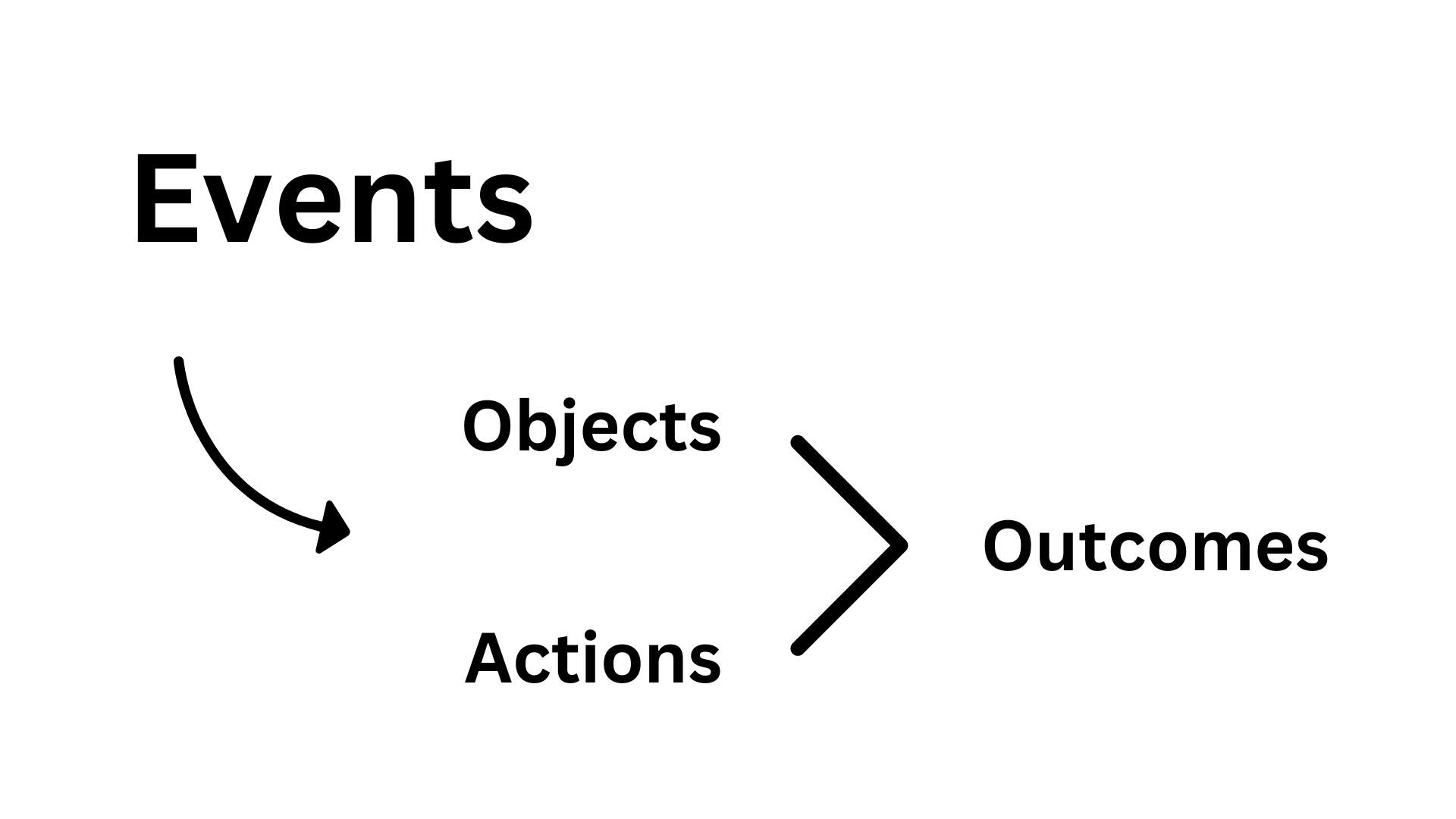
1. Establish willed-for outcome
The outcome is the reason for thinking about events. One event can have multiple outcomes but I think it is easier to start with one important event that the characters/players want to happen. In The Wyrd System I call this a willed-for outcome. Typically we will only be “resolving an event” when something dramatic is happening and so the players are trying to achieve a specific outcome.
Often this outcome is clear from the narrative already given but it should be clarified with the players.
The players want to get their teacher off the rock
- Establish relevant objects/actions
Once you have the desired outcome, you can begin to establish which objects and actions relate to it. These can be picked from what is being said at any moment as players/GM describe what the characters are doing, or the environment. Often in the flow of discussion there are many details being given. The desired outcome helps you to select from those as you can focus on those which directly relate to the desired outcome and ignore the others.
In play this typically looks like asking people what their characters do to try and achieve the outcome they want. If things aren’t clear, this is an opportunity for players to add more into the narrative.
Warrior A has a heavy shield that they want to try and surge forward and crash into the teacher with; Warrior B has been training with the spear and wants to try and trip the teacher at the same time. Warrior C decides to hang back and observe - and so isn’t necessarily a part of this event. But they recall how the teacher (their parent) has an injured right leg they haven’t told anyone about. Warrior C is certain they would have told the other warriors.
- Consider how the outcome is affected by the objects/actions.
The way in which the objects/actions interact determines the possible outcomes that may come to pass. This is a creative and often intuitive process that comes - for me at least - with trying to imagine the physicality of a situation. Typically I take quite a gut-led approach to this but I will often ask players if I’m not sure how things might work. I also sometimes list out the things I am thinking about, partly to give an option to players to add extra thoughts and ideas as well as play with my own.
The charge of warrior A with a shield will need a lot of momentum and strength, but will allow for limited manoeuvring. The tripping of the legs by Warrior B may work well with the shield bash but runs risks of leaving themselves vulnerable by lowering their weapon, and also it may be difficult to control the weapon among the flying legs of the combatants. I also know the teacher is proud and will likely be ignoring their injury and not account for how much it might impact them.
- Determine the actual outcome.
Finally I use a tool to tell me how close/far from desired is the outcome. I use the Wyrd System which is designed around my process and gives me a varying set of outcomes as to how close or near to the willed-for outcomes comes to pass.
From here I take the interactions between objects/actions I have identified and narrate them happening with a mind to getting through our change of state, our outcome, to allow for a future event. Often as I talk I am still processing the objects/actions and their interactions. I personally allow my players to add things here as far as they make sense.
We end up with a Wyrd System result of 2: ‘The willed-for outcome comes to pass but with a significant complication.’ I decide that they knock the teacher down but their injured leg makes them fall faster than expected and Warrior A falls with them, and Warrior B’s spear ends up dangerously tangled among their legs.
[Bonus thought] Difficulty and why it doesn’t really exist
Typically in order to find out how good/bad the outcome is, people introduce a difficulty to a roll. Hang on - I just said “how good/bad the outcome is” isn’t difficulty about whether or not the desired outcome comes to pass?
While this is sometimes true I think most uses of difficulty are really about scales of success. Obviously some systems encode this in them but even when they are binary this is still true (I will say I am not talking here about “to hit” difficulties, number-combat systems being their own, um, special thing).
Let’s work through the example of killing a womp-rat.
Imagine a typical d20+modifier system where a total of 35 could be described as “impossible” what DC would you give to hit a womp rat with your gun? Maybe a 10 or 15? If they “fail” what’s the worst that’s going to happen, they accidentally hit something else or look foolish for failing to shoot a wild animal. If they pass, they kill(?) the womp rat and look cool in front of their painfully uncool friends.
Now let’s imagine hitting something of equivalent size, with a much more sophisticated weapon but the outcomes now link to the fate of the entire galaxy. I wouldn’t give the same DC. So now I, as GM, say “Hitting the exhaust pipe, without the targeting computer!?! The DC is… 40!” and bask in the resultant guffaws of astonishment at such a high number being said out loud!
The actual act might be a similar difficulty, but I could never give the same DC here. This is something you see in actual plays all the time: “give me a perspective check, difficulty of just 6” - because the outcomes are totally insignificant and no matter what the player rolls they’re having everything explained to them. Or the opposite side being: “I’ll allow it if you get a nat 20 right now” because again the outcomes are going to be significant.
So yeah, difficulty doesn’t really exist except as a banding of outcomes. [If you are feeling the urge to um actually about whomp rats and exhaust ports, i beg you to consider how flippant I was being and consider if its worth arguing with a fool].
My games on itch; Email:wyrdrpgs@gmail.com; Bluesky:@thewyrdlands.bsky.social
The Wyrd System
The Wyrd System is a system to support resolving the outcomes of events. It can handle any type or scale of event; to be quick to interpret as the GM or in solo play; and to allow for the results of rolls to be hidden from players.
You can find a full pdf and plain text version of this on my itch.
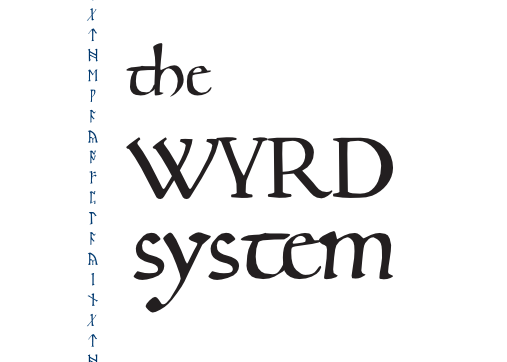
The System
At its simplest, the system has the GM rolls a d12 (the Wyrd die) and a player rolls a d8 (a Will die). The difference of the numbers is found. The smaller the difference the more things go the way the player characters want.
When the outcome of an event is uncertain or dramatic use this system. This event might be as small in scale as a single action, or as grand as the outcome of a battle between gods. The event will have at least one willed-for outcome. This will normally be what the characters want to have happen. This willed-for outcome should be clearly established between the GM and the players. When this has been done, roll the dice.
Rolling the Dice
The GM rolls a d12 called the Wyrd Die. This is rolled either in secret or in the open. For each willed-for outcome in the event a player rolls a Will die, a d8. The results of the two dice are compared. The smaller the difference between the dice, the more the willed-for outcome comes to pass.
For each significant character acting upon or influencing that outcome nudge the result on the d8, moving it 1 point towards or away from that on the d12, effectively increasing or decreasing the difference depending upon the support or opposition of the willed-for outcome.
Difference of 0: the willed-for outcome happens…
Difference of 1: …with a downside or complication
Difference of 2: …with a significant complication
Difference of 3: …in such a way that you might wish it hadn’t or that sets up a very significant complication
Difference of 4+: the willed-for outcome does not happen and increasingly its opposite does
Nudging
In an event, the characters can push for their willed-for outcome using their actions, expertise and knowledge. A player can give in-world narrative reasoning for a character’s ability to influence the outcome. If the GM and table consider that to be impactful then allow a nudge of 1 per character. This means moving the result on the Will die (d8) by 1 towards, or away, from the number on the Wyrd die, changing the difference and the outcome of the event.
Nudging does not have to be labelled as such in-play.A player may describe their characters’ actions and the GM can interpret that as a nudge. If players have not voluntarily shown how they influence the event, ask them how, or if, they are able to do so.
The narrative descriptions linked to nudging are valuable in determining outcomes. For example, if a player describes them physically pushing themselves to achieve an outcome and a complication emerges it might involve them damaging their body.
This is the system in full, but if you want to see an example of its application and some thoughts about certain considerations (e.g. about when to nudge, the odds etc., please check out the full version available for free here on my itch page)
Why I love this system
For me this is essentially the perfect dice system. It started life as me editing DnD 5e to try and make actions more simultaneous many years ago, over time - and especially when FKR emerged - it became simpler and simpler until I got this current state.
I use this for just about everything I ever play and have yet to find something that it doesn’t work for. Even just as a GM, a quick drop of the two dice helps me to clarify what I think should be happening in a few seconds.
The thing that keeps me on this system so strongly is that it is fantastic for playing with a Play_Worlds mentality. That is, an approach that sees the players key task as being experiencing the nature of a fictional world in which the influence of “the table-world” (dice, character sheets, cards, moves, etc.) is as limited as possible.
This system does this in a few key ways:
Secret results
Most dice systems use a roll high/roll low model. Typically one can tell at a glance that a 1 is good and a 4/6/8/10/12/20 is good.
Take the following. Player: ‘I want to try and lie to the king about who stole his goat’ GM: ‘OK, roll a d6 and add you presence score.’ Player: ‘I rolled a 1. And I add, um 0.’
In this situation, the entire table is able to do something that is almost impossible in real life: they know instantaneously that a lie has “failed”. That shared table-level knowledge that comes from the dice then dictates the behaviour of the fictional/game world.
In The Wyrd System, if the players want to roll but we (the GM) do not share the result on the d12 then the following happens: Player: ‘I want to try and lie to the king.’ GM:‘OK, roll a will die.’ Player: ‘I got a 3?’ GM: ‘Cool. The king…’
[As an aside, I am not saying this is what happens in all systems, or that what I am doing here is the only “solution”, or that in fact it is really a problem at all.]
Nudging over Modifiers
This system does not have modifiers tied to things in the world. There are no +1 axes, nor +2 to presence. Instead it allows for any type of fictional-world input to have an impact on the outcome of the event. If a player gives a clever description of how they will lie to the king (and the GM decides a roll is still necessary) that may turn into a nudge of 1 or 2, which massively improves the odds of success. If a player draws on some aspect of the shared history of the world, or a part of their back ground, the same may happen.
The players do not need to explicitly call this out, in their natural description of their actions they likely draw on the things in the world. A GM can apply a nudge that makes sense purely from the fictional world or narrative given by the players or which they perceive for themselves.
This system does work really well alongside these modifiers though. I ran a short campaign of 5e a couple of years back and, behind the screen, used this system to help me refine the simple binaries of pass/fail. What I would do is translate the bonuses a player had, or the dice result, to being a substantial nudge that made the outcomes better/worse. I would feel comfortable pairing this system with almost any other number-based mechanic for health etc.
Events over actions
The Wyrd System is a system that is designed to resolve events, not actions. It might be a bit hyperbolic (read, definitely is) but I think that the best thing a GM can do to improve is to think about events instead of actions.
Events are the building blocks of narrative (literally, narrative is pretty much defined by events). What this means is you have a series of objects (characters, things, details) and some actions then together they create an outcome that leads to some kind of change (or continuance) among those things.
Events bring together multiple characters, multiple features, they allow for dynamism and collaboration. Actions can quite limiting to resolve, they tend to include one character doing one thing to one other thing at a time. Once you add in anything like initiative action resolution has a weird impact on the nature of time in a world in which time becomes segmented and people exist in little pocket dimensions that act independently and then re-join together. Events are how we naturally divide time in narrative.
I could rant about this a lot longer, but The Wyrd System wants you to think about events and their outcomes and for me that is a good thing.
This system seems a bit odd because it doesn’t have the normal roll high/low thing of most dice systems. This can make it seems slightly unintuitive, but maybe have a god - dropping a d12 and d8 feels like you are casting ancient bones or lore and magic, and it is a quick easy to use system.
My games on itch; Email:wyrdrpgs@gmail.com; Bluesky:@thewyrdlands.bsky.social
What is a literary RPG?
Snow is hosting a Literary RPG Jam on Itch which I actually think I have something to submit to: a medieval, vampire hunting scenario. My background is also English Literature and I am a fairly avid reader/writer of what is sometimes called Literary fiction so this jam is right up my street and I am excited to see what people submit.
I thought I would take this opportunity to discuss, in my opinion, what could make an RPG “literary”. It is not a simple question, particularly because the term is tied up with so much baggage of status/seriousness/quality and discussions of “high” culture. In short a great many people can see the term literary and simply decide it is not for them.
There is also an interesting overlap with the idea of the Lyric Game, an interesting jam of which was recently held by BreathingStories on the topic of birds. What that overlap is, is perhaps worth discussing in its own right. But I think we definitely can distinguish these two things. In short we might say while most lyric games are literary, not all literary games are lyric. I actually think a traditional dungeon crawling adventure has as much “chance” to be literary as any other game.
Let’s start:
What is the genre of “literary fiction”?
In the world of fiction writing “literary” is a term used by publishers and booksellers to denote a specific genre. It is a genre that tends towards human dramas, often with some kind of social-issue setting, typically set very much in the “real world”. It also often means that there is a slightly higher chance that you are going to get more complex language, or less standard structures.
Open Water by Caleb Mzumah Nelson is a good example of a recent popular piece of literary fiction. It is a novel about a young black man in London, structured around a burgeoning relationship, grappling with his identity within the context of his gender and his race. It is written in the second person (the protagonist is “you”) and an, at times, essayistic manner: ‘You said to trust is not to fill time, but you would like to say to trust is to fill that time with each other. The heart does the same, in the immense darkness of the body, filling with blood, clenching it out, tight as stiff fist with nothing in hand.’
This is, undoubtedly, literary fiction.
But - I would contend that the literary nature of it is tied less to the “genre” elements of the subject matter and more to two other features: the language and perspective. A traditional “genre” piece (sci-fi, fantasy, etc.) can be equally “literary”. Therefore for me, the more human drama elements is not a requirement to call something “literary”. Instead it is aiming for something like ‘non-representational writing’ and, more importantly perspective.
What is “literary”: non-representational writing
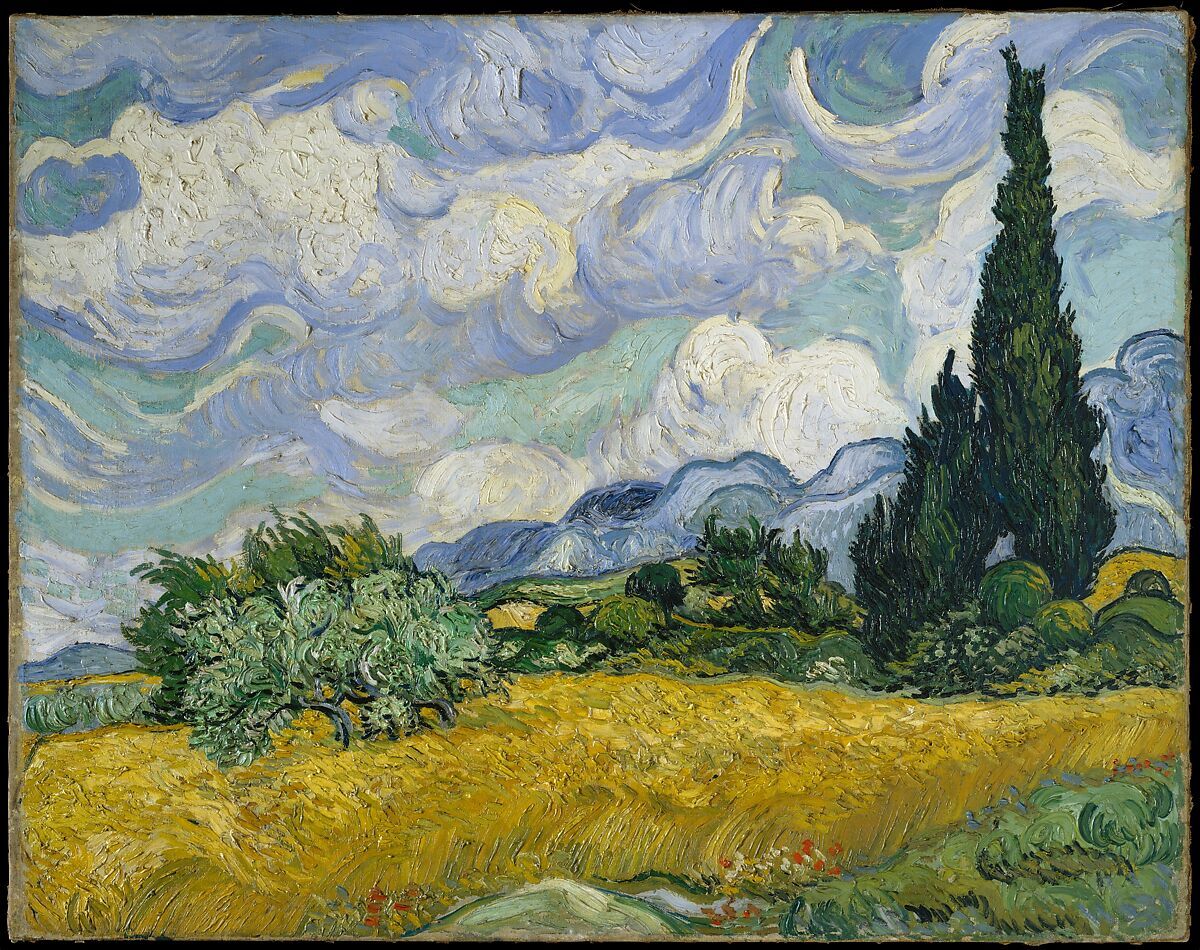 Representational?
Representational?
Non-representational writing is slightly hard to explain. We might also think of it as “evocative” or “stylistic” writing. This is in contrast to writing that tries simply to directly refer to a real world object (even if the world is imaginary).
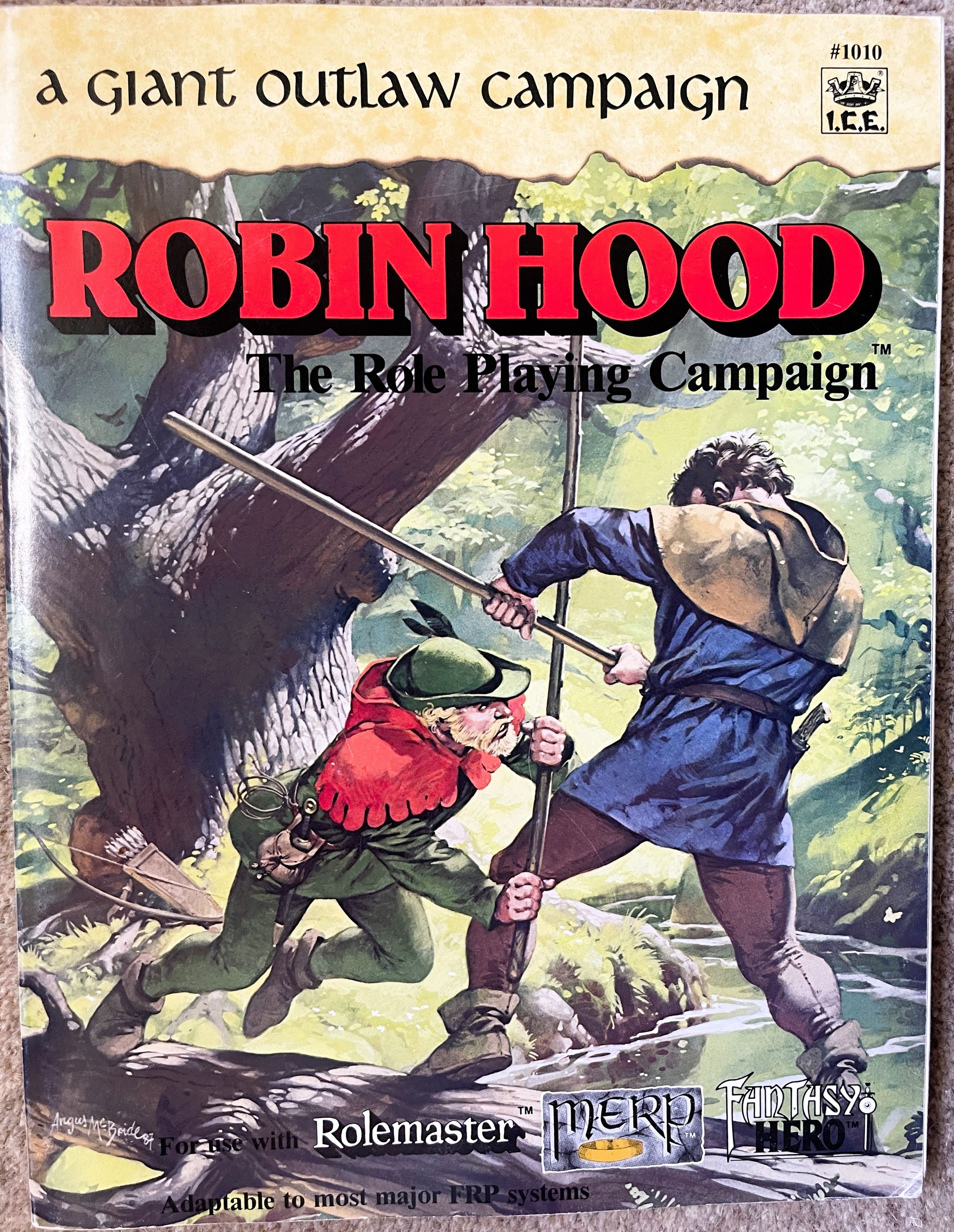
Let’s take a simple example from Robin Hood: The Roleplaying Campaign. This is p.77 and is describing a gatehouse in an abbey: ‘The gatehouse is a small arched extension of the Outer Buildings, kept by two monks and two lay members (porters). They greet anyone arriving, keep accounts of stuff brought into the Abbey and bar the gate at night.’
This is language that we might think of as straightforwardly descriptive. It is telling me information in an unambiguous way about a place that the language assumes I will trust is “real”. The choice of language (apparently) conveys nothing about the place except for the literal details it provides.
Let’s take a second example, this from Transmission for Them,‘Space splintered before you. Warring fleets reduced to shards, like glass, frozen at the moment of its shattering.’
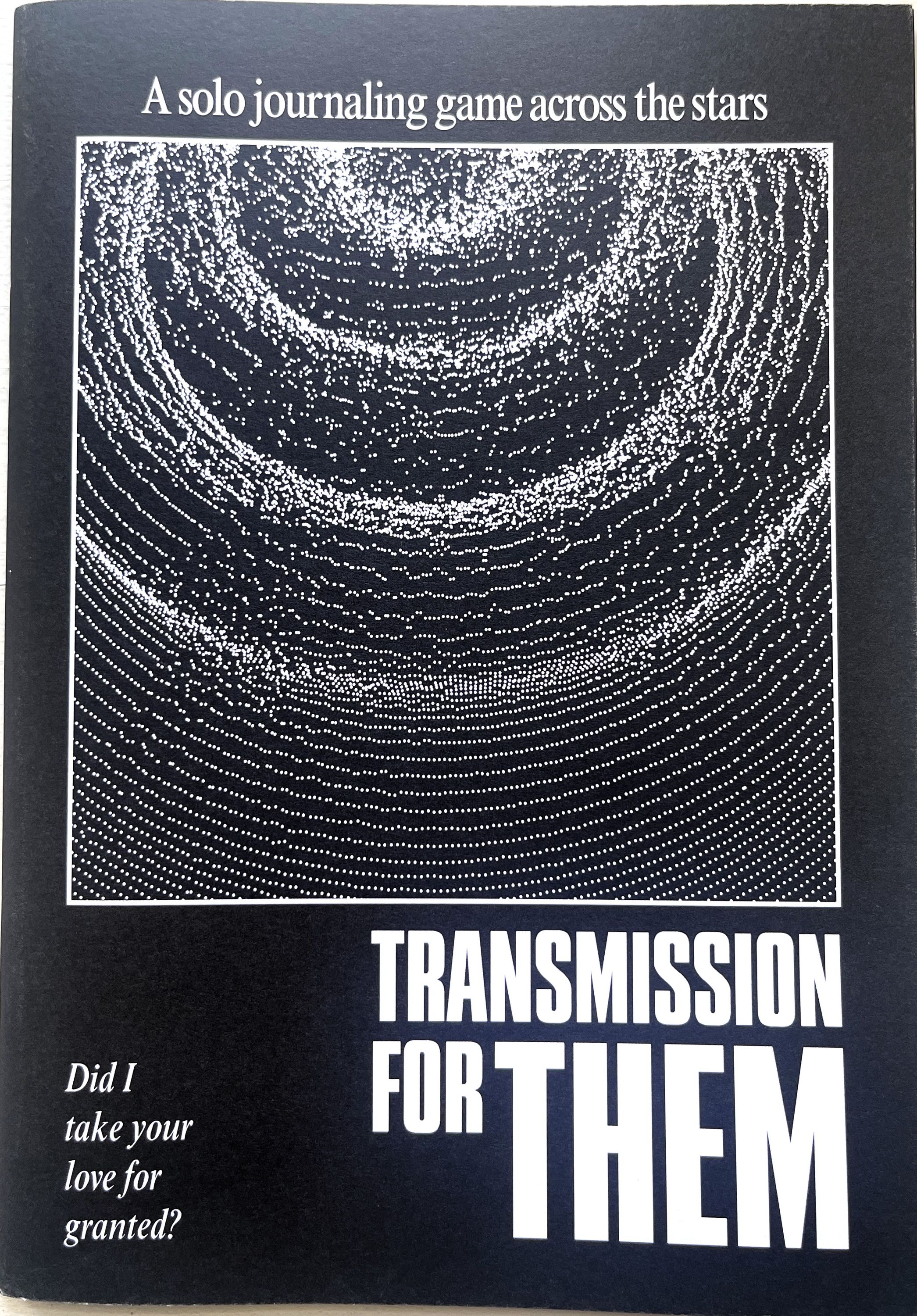
This is not supposed to be a simple description of an objective world. In the language choice the images are more self-referential: that is, they are more ambiguous in meaning, the language asks you to look at it and consider its meaning: What does it mean to say space is “splintered”? The images you generate here, the meaning that possesses will depend on your past experiences of the language or of things being “splintered”. The unpredictable leaps that your mind make in combining terms you may not have come across together (space, splintered) before. The language is not trying to suggest that there is only one interpretation, it is inviting multiplicity of interpretation. It is not tied to one “real world”.
Now, You might think on reading these two examples that perhaps the difference between them is only a matter of perspective. Perhaps we could find the same “multiplicity of interpretation” in the meaning of “greet” or “anyone” in our example from Robin Hood: what does greet really mean? Are they really greeting “anyone”?. Our second feature of literary helps us explore this and perhaps helps us to see that truly referential/objective language is perhaps a bit of a myth.
What is “literary”: writing from a perspective.
For me, this is the crux of what makes writing literary. It is when writing considers the perspective of the speaker and changes based on that perspective. A lot of RPG writing (and we might say GMs - though that is a topic for another day) follows the pattern of a lot of fantasy writing in that it attempts to present an objective perspective which can claim “this is what the world is”.
Let’s take an example from Rebellion talking about the intergalactic wolf-like race of the Vargr: ‘IDEOLOGY: Plunder. The Vargr have no real ideology with which to support their actions. Many explanations and justifications can be presented for their actions, but all are fluff to cover the basic pack instincts of the Vargr. Given a leader and a target, the Vargr will seek it out.’
That is, they are baddies. They handily have a skull and a nazi-like uniform to aid this impression: 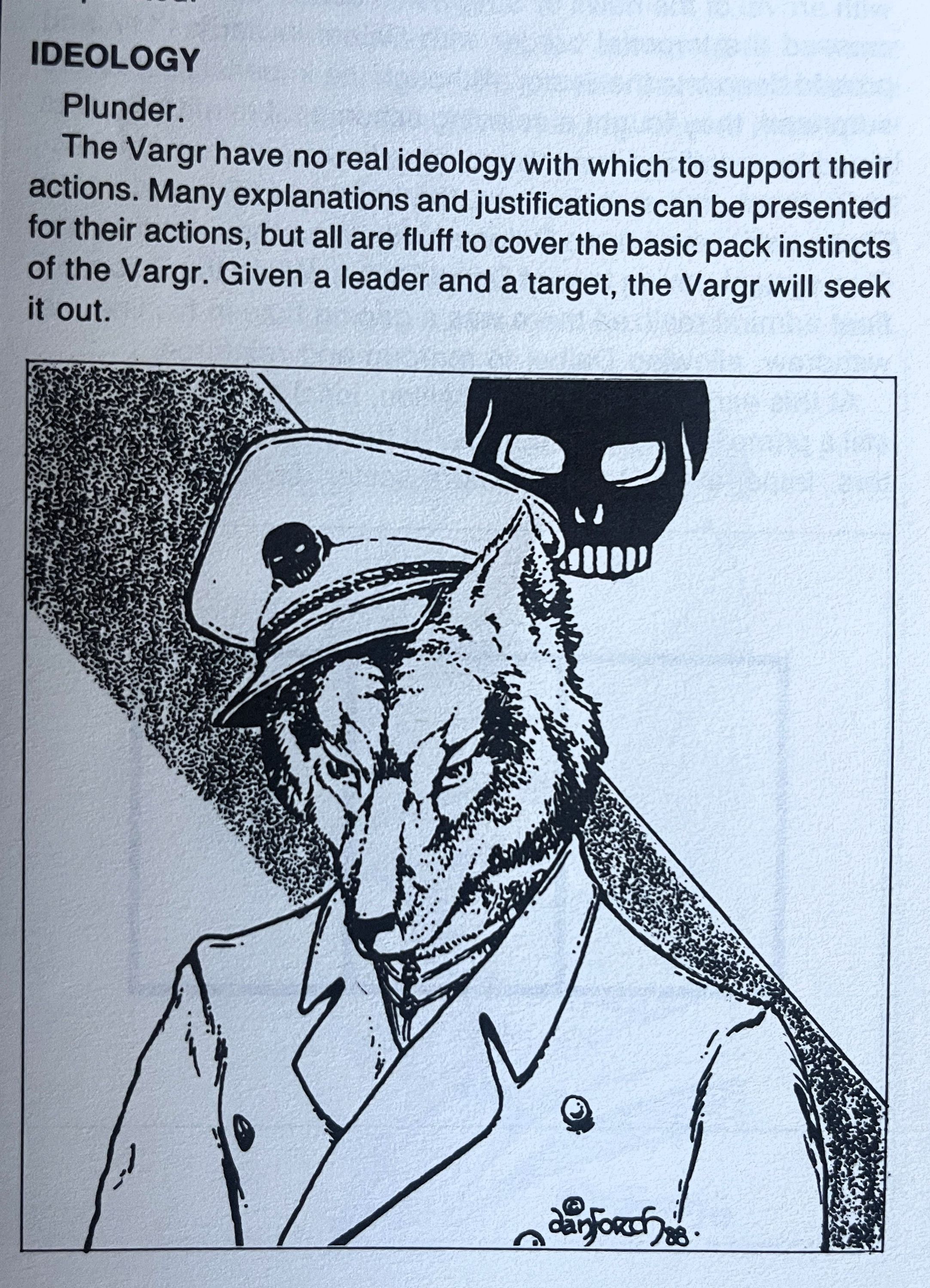
Now this is presented as factual, and no where else does the writing try to present a contrast to that nor point out the inconsistencies in its description of this group. However, there are inconsistencies. The rest of the spread on the vargr talks about their interrelationships, their political beliefs. The writing is at pains to tell us they are baddies, but nuance leaks through and shows us that there is something else going on. Who is it who is saying they have ‘no real ideology’ who is it who explains the ideas away as just ‘fluff’?
There is a phrase from the cognitive biologists Maturana and Varela that I always bear in mind in instances like this: ‘Everything said, is said by someone.’
Literary writing does not try to hide or occlude this fact. It recognises and leans into it, allowing for spaces of multiple perspective, of disagreement with dominant perspectives (including the narrator). There is a clear link here to RPGs. Some RPG texts try to tell you how the game must be played, the only correct interpretation of rules, setting elements and so forth. Some RPGs, point out the uncertainty and openness to multiple perspectives.
I’ll give a brief example from The Morose Society: ‘Necromancy is not the most well regarded of art, detested and feared by many. And it is all these fuckers fault’. Here we have two perspectives being shared the second (in italics) is clearly expressing some kind of in-world perspective that is not explained but opens up play to different interpretations. But even the opening sentence is showing some kind of perspective that hints but does not determine the nature of the world.
Writing a Literary RPG
If you want to set out to write a literary RPG we might some up what these ideas suggest into a few thoughts:
- Evoke the world rather than describe it: when giving details use language that is open to (mis)interpretation, try to avoid language that is too “objective” and trust the analytical powers of your readers (which are vast, if we allow them to be).
- Think about who is speaking: when you write, ask yourself who is saying this. Another way of thinking about this is asking yourself who in the fictional word you are writing about is the information in a piece of writing “accessible to”. If you look back at all of the examples I have given with this question you will start to identify myriad perspectives lurking beneath the surface.
My submission: The Unburied
The game I am going to submit to the jam is called The Unburied. It tells the tale of a medieval village, seemingly plagued by the arrival of a vampire. The players are people from the village charged with hunting down the vampire. But who is telling the tale, and what really is the vampire?
I’ll write about it soon.
Making a Medieval Manuscript Layout
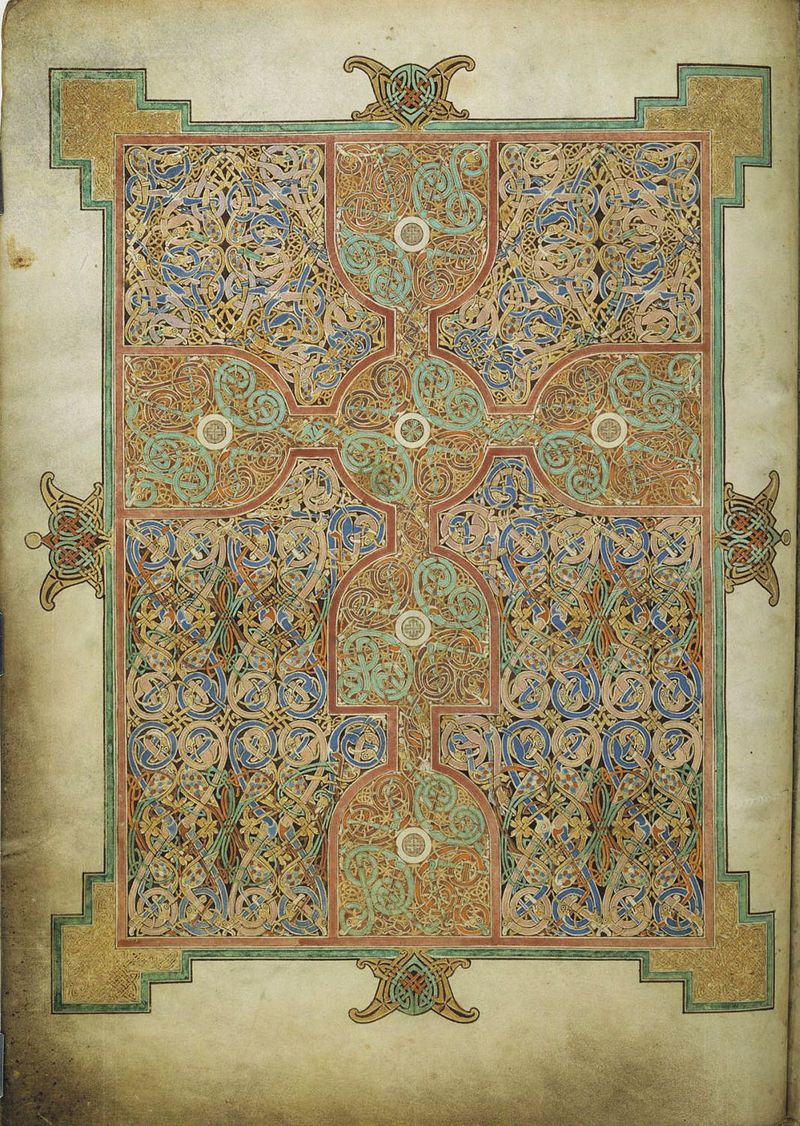
I have been trying to develop a working layout which I can use to release bits of (the eternally forthcoming) The Wyrd Lands. This is a game inspired by the world of Old English poetry - of Beowulf, The Wanderer, etc. As such I want a layout inspired by the medieval manuscripts that capture this writing. This is a slightly challenging source of inspiration and in this post I am going to talk about my initial forays.
This is also a place for me to share a lot of links which might be the most useful thing in the post - just like an online recipe, they are at the bottom after the guff. A lot of these are taken from things people have shared on the NSR Discord, so thank you to those people.
A note on variety
One of the issues with anything about medieval manuscripts is that it can make you think they were a homogenous whole but really they occupy about 800 - 1000 years of production across the world (if you include non-European manuscripts). So there is a lot of inspiration to draw from and not a lot of consistency. If you want a glimpse of just how many there are, this database of digitised manuscripts gives a sense of scale.
My particular starting point is the Lindisfarne Gospels, for the main reason that they were written around the time Beowulf was likely composed and they are stunning. They were once fully digitised by the British Library but following a cyber attack the entire collection of digitised manuscripts is unavailable.
The Layout
There are a great many layouts used in manuscripts. Here is a pintrest link to a selection that shows some of that variety. I originally wanted to follow the Lindisfarne Gospel which has a model of two columns with the right hand column slightly thinner than the first. This is interesting but it reads so oddly to modern sensibilities that I couldn’t use it.
A lot of manuscript pages have quite large, often a-symmetrical, margins. This may have aided with holding the book but perhaps more interestingly it leaves space for annotations, comments, indexing and so forth. This is one of the most interesting parts of medieval manuscripts: their use over time and the fact that later scribes and users have added comments, explanations, tranlations and so forth. Therefore I decided I wanted a large margin on one side. Something like this 15th century book:
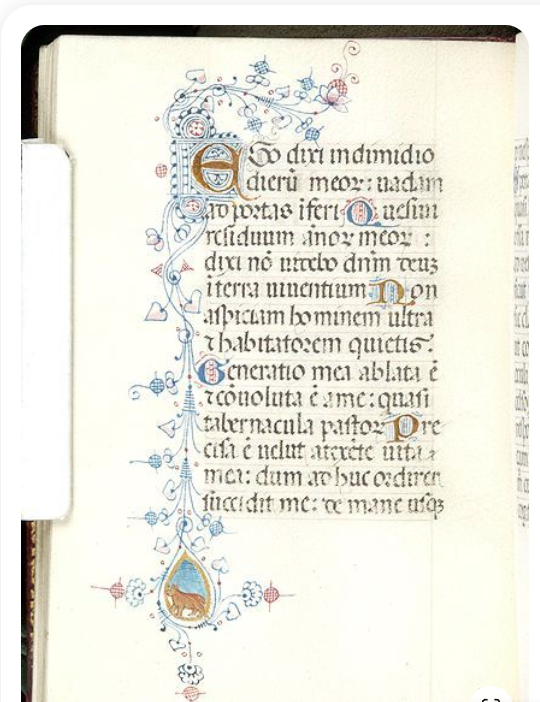
In order to figure out the proportion of the text to the margins, I wanted to use some kind of grid system. The layout for these books was very carefully designed and developed. In some cases it may have been following principles that have been lost and (potentially) reconstructed. These are the so-called canons of page design (explained well here). However, I didn’t just want to use one of these and be done with it - both because they didn’t give me the look I was going for, and I think the actual historical reality of them is pretty dubious, I found very limited mention of them in academic writing on manuscripts.
However, the mathematical element of manuscripts is they build on is obviously valid. There is a grid system underlying a lot of medieval manuscripts (even where it is broken), such as in this example:
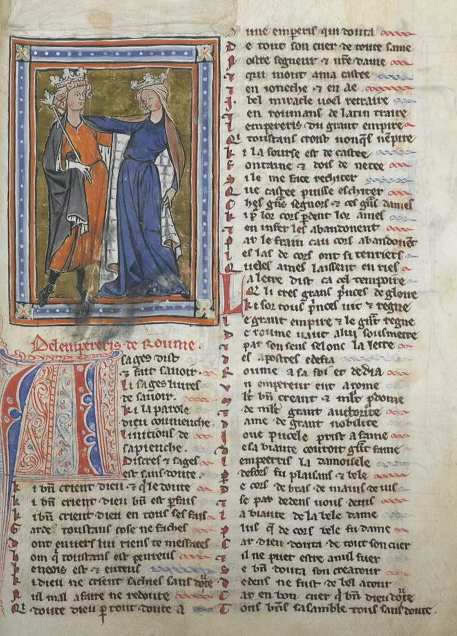
In some cases this sees image and writing wrapped around each other in ways that today would feel baffling to read. I spent a bit of time looking at the grids of some manuscript pages, but just fell back on working in 3s. So I split my page vertically into 12 and horizontally into 9. The margins are 1/9 on the left (outer), 1/12 on the top, 2/12 on the bottom and 3/9 on the inner. Which looks like this:
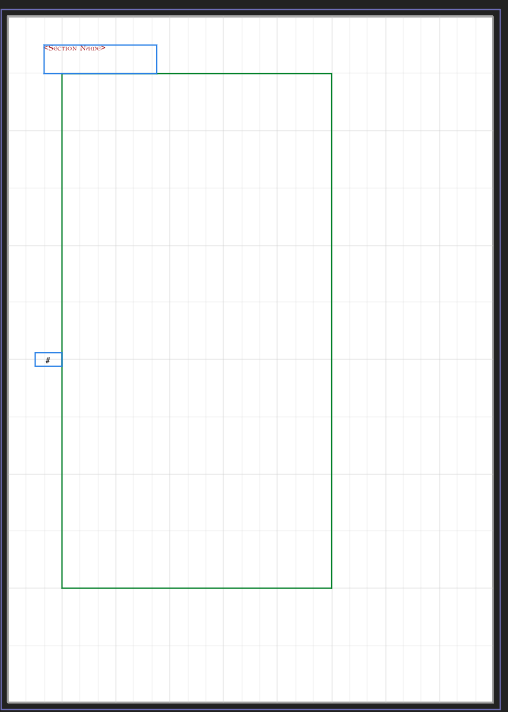
I might end up changing this but for the time being I like it.
Paragraphs and Headers
One of the big challenges for taking medieval manuscripts as an inspiration is the fact that standard ways of showing paragraphs and headings are different from today. Let’s take for an example this page from the Moore Bede from the early 8th century:
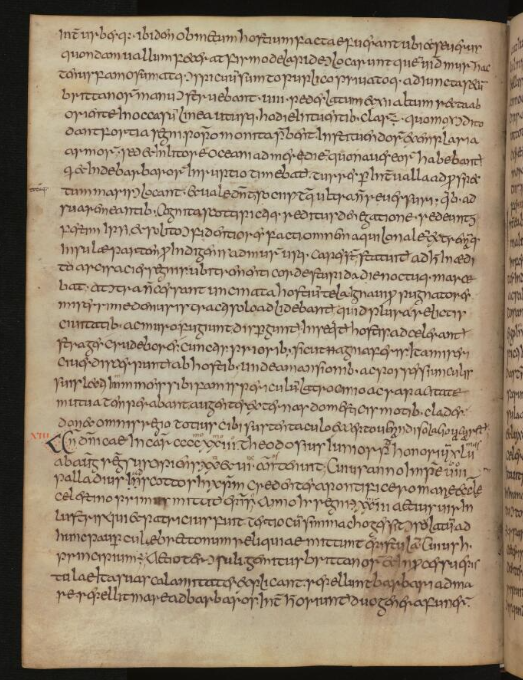
This is the marker for a new paragraph (I think)
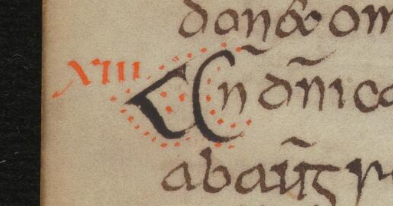
Another pair of examples from the late 11th century:
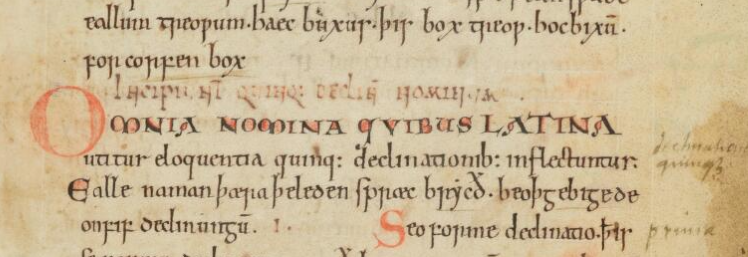
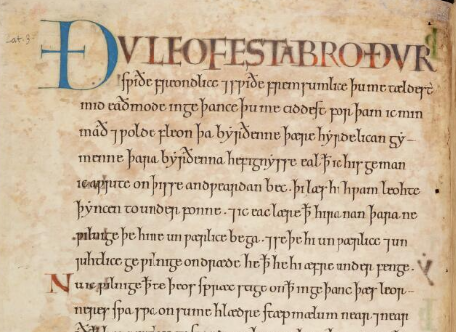
Which become the much more elaborate designs we often think of as in this 14th German example:
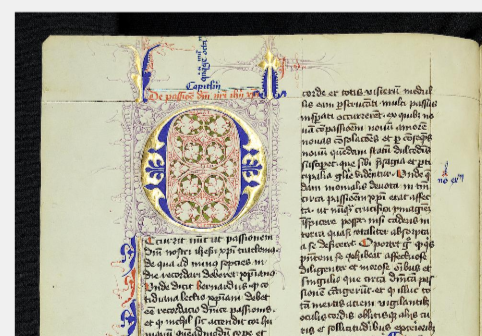
Now in my own writing, I need a nice line break between paragraphs, normally I don’t even like an indented paragraph (itself an interesting left over from manuscript production). So I keep a line break between paragraphs. Therefore I am indicating a section, rather than a paragraph. The most commonly used way of doing this seems to have been with the initial character or with the initial line. Typically with a colour difference, font or size difference, offset, or with the use of an illumination.
I have been a bit stuck on this but this is where I have settled:
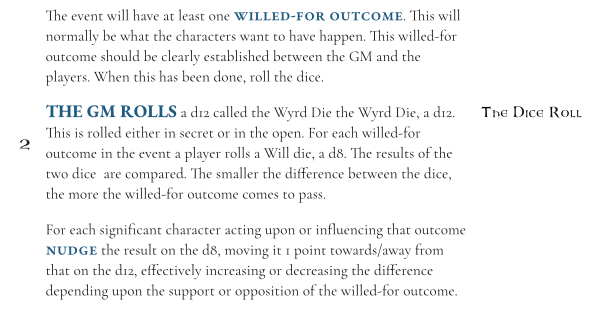
I have tried with a sort of initial character, but I think it gets lost on the page and doesn’t clearly indicate change enough to a modern audience used to headings.
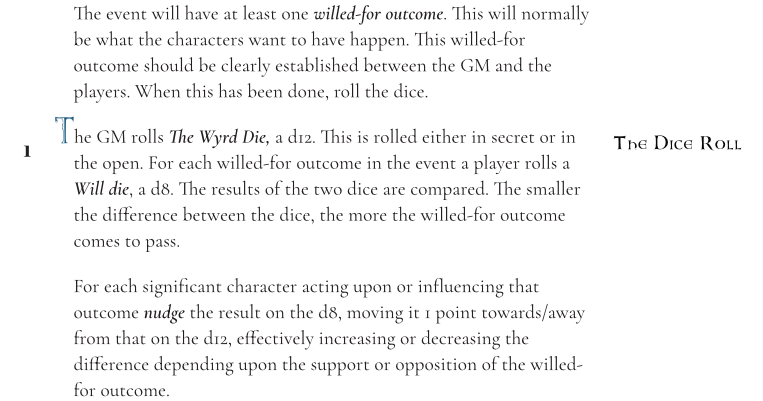
One of the challenges here is with balancing the fonts, and the additional use of an “annotation” almost functioning as a heading.
Fonts
Ah Fonts, the never-ending well of decision-making. We have got a number of fonts to think about here: the body; the “heading” or bolding fonts used to mark sections; and (multiple) annotation fonts.
The body font has to be a relatively modern font and I have just followed my own tastes witha light serif font. The one I am working with is Cormorant Garamond, though I may switch to Elstob partly because it can handle medieval characters. Anything that looks any more “historical” just impacts on readability.
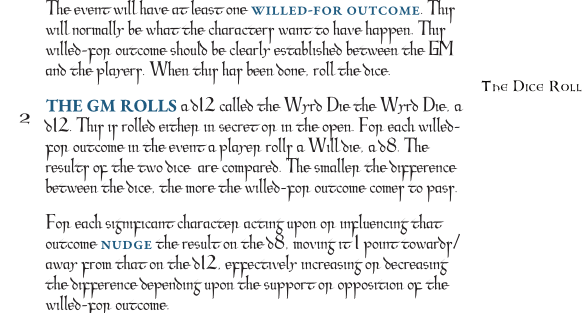
Because of using a modern font for the body, selecting a font for the “heading” is tricky in that the historical fonts look older than the modern, even though they are supposed to be later additions. For the initial character, I have taken the initial font from the exter book, which is a truly fantastic set of fonts that I am also using in the annotations. However, as before I don’t think I will use this as it just doesn’t match modern tastes.
For a while I also switched between Uncial Antiqua and Lombardic. The issue with using both of these fonts is that they look so different from the body that they feel disconnected from it. They have to be different from the annotation fonts as they were written (theoretically) by a different scribe. However, using a historical font for the heading clashes with the ones used in the annotations. Therefore I have just settled on a bolded form of EB Garamond, which gives a heavier weight but is still obviously written by the “same hand”. I’m not fully satisfied with this but it’s enough to start working on.
Annotation Fonts
The annotation fonts are theoretically coming from multiple different scribes. The first “The Index Scribe” went through and put useful notes to aid the reader in going through a text. There is an interesting video on discontinuous reading which is something I want to work with and this kind of annotations works to do that. We can example of this here:
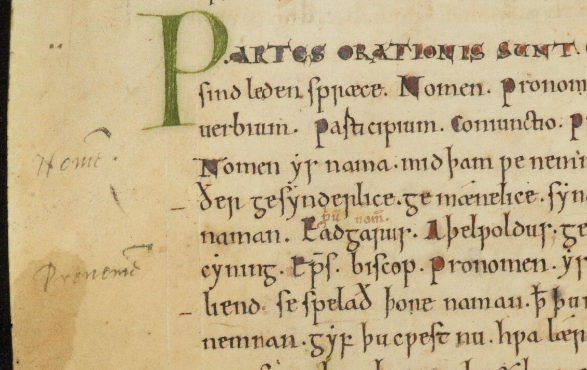
This kind of work seems to be typically done in handwriting as some later user has put this in for the contemporary users of a book (in the image below you can see where a later user has put in page numbers, it looks like in pencil). However, I want this to support the function of being a “heading” in the text and nowadays this style of font, the looser more handwritten, essentially means ‘less important’. Therefore, I wanted to use a historical font which that still looks like a heading for a modern reader.
This takes me back to Uncial Antiqua and Lombardy. At the moment I am settling on Lombardic because it has a lightness that fits better with the page. However the Uncial is closer to the font of the Lindisfarne Gospels and does also look more like a modern heading.My initial draft of this was just a pretty standard structure with subheadings using this. It looked good (maybe better!).
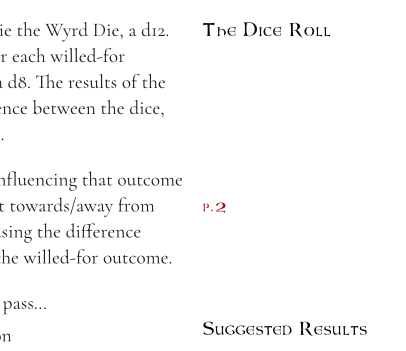 Lombardic Annotation
Lombardic Annotation
The second annotation that I am using is replicating the idea of ‘glossing’ where a later scribe has come in to explain, translate, or comment on an original manuscript. For example:
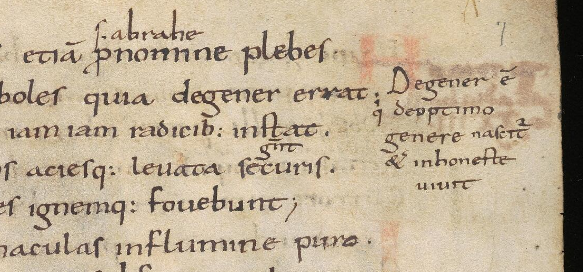
For this I am using the font called BeowulfOT. This is version of the text from the Nowell Codex which has the right look but doesn’t include the long S or r of other facisimile fonts like EBH facsimile and Pfeffer Medieval. I love this font.
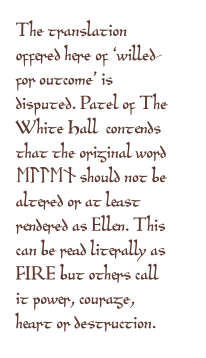
Colours
The use of coloured writing is called ‘rubricing’ which literally means “reddening”. I have however decided to use a blue for the headings. Rubrics didn’t only happen in red, blue and green seem common as well. Red also looks like a grey in a lot of cases of colourblindness (you can check this on this fascinating site) whereas blue stays mostly blue and so may standout. For the indexing I will use red at points because it doesn’t need to contrast with the text around it, so it becoming grey doesn’t matter.
I’m also probably going to put the annotations in different colours to help them stand out as not being written by the same hand.
Page number, Tables and Lists etc.
I have put the page number in an odd position in the middle of the outer margin. This is the position for the first ever printed page number (which came in very late). I’m probably going to repeat it alongside the section title in the top margin, just to help with readability.
I haven’t done too much with lists etc. I am probably just going to keep them fairly standard and modern as, along with the rest of the body it needs to be readable. I’ll probably try to do something prett for the table.
Illuminations
At some point I will have some dedication illuminations for initial characters for chapters, margin illustrations, borders and so forth. But that is time and money down the road. My working style for this will to combine elements of framing and composition from later medieval things, but using the images and patterns of anglo-saxon or celtic art. I want some marginalia and doodles as well. Here is a very rough example:
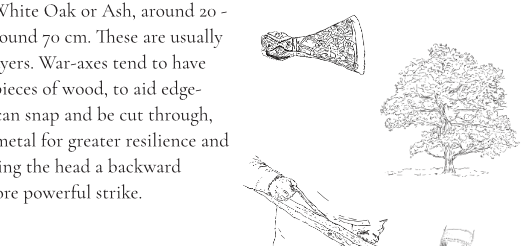
Conclusion
There we go, this is an endless pit of thinking but an enjoyable one! Below are some of the links and resources that I have used (and will continue to do so). But this is a full page:
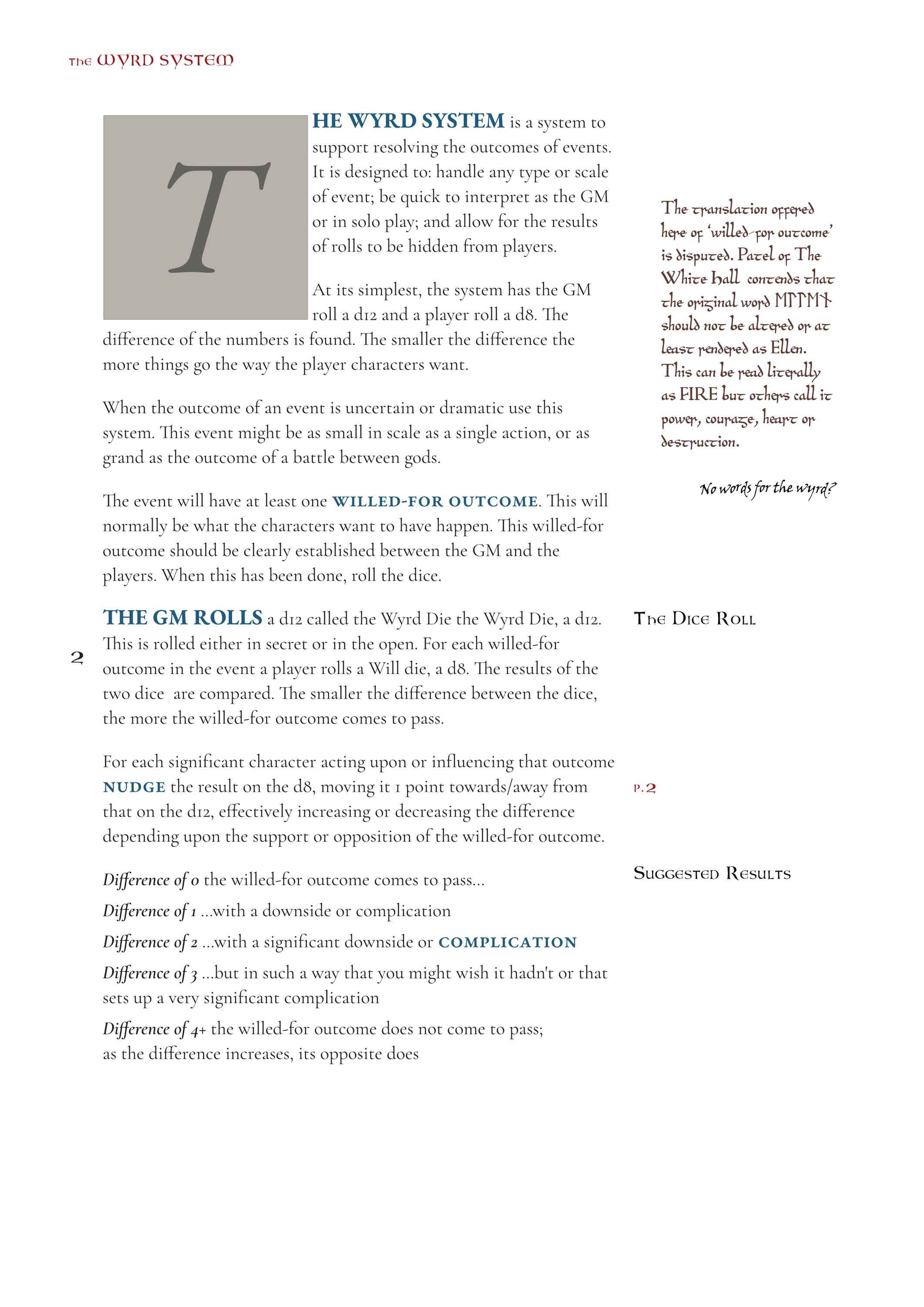
Manuscripts in general
- Nottingham University’s guide on how to research manuscripts which gives a lot of simple explanations of terminology etc.
- A nice libguide to manuscripts with videos, recommended reading
- Some videos from the University of Leiden giving a fascintating overview
Collections of Manuscripts
- A big repository of links to digitised manuscripts
- A pinterest collection of many different layouts
- The Cambridge collection of digitised Anglo-Saxon manuscripts
Layouts and decorations
- An overview of margins and the canons
- A short overview with examples of decorations
- An overview of the history of the pilcrow
- Summary of the first page number
Fonts
- A directory of fonts that handle a huge range of medieval symbols
- A second directory of historically inspired fonts all by Peter Baker, including the versatile Elstob
- Another example not part of this is Elstob
- A great set of fonts taken from the Exeter Book
- BeowulfOT, a font based on that from the Nowell Codex (Beowoulf)
- A ‘Golden Type’ font for a strong victorian-medieval look
- A site allowing you to analyse colours for colourblindness
Pandora’s Box: The Last Province’s Review System
In the old RPG magazine, The Last Province, they used a standard format for their reviews, based around a 6 categories with each getting a score out of 6: Writing, Art, Usefulness, Playability, Production, Value. To start off a series of random thoughts on old RPG products (purchased on a rainy June day from Glasgow’s Static Games), I am going to review that review system.
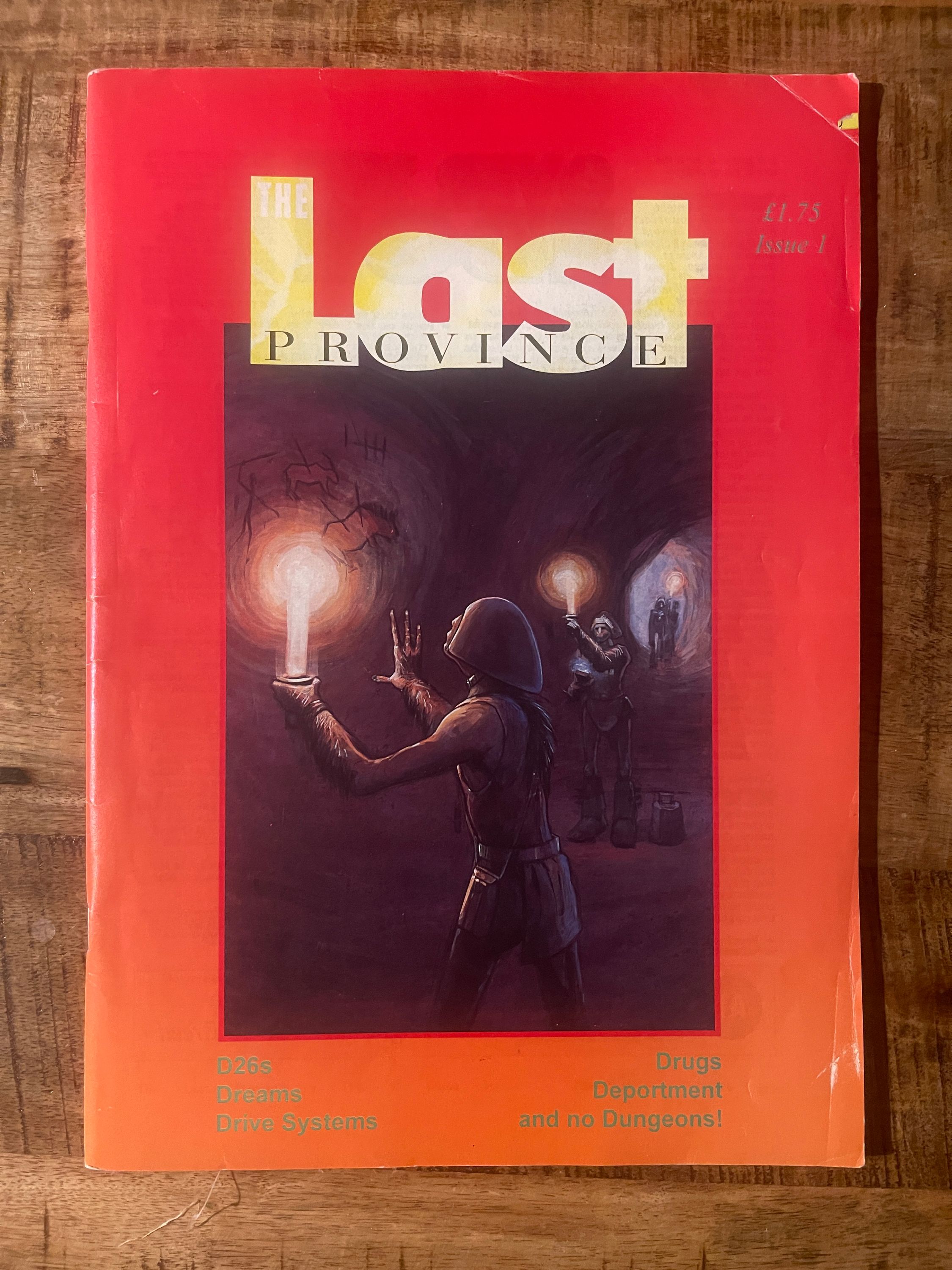
Here is the review system. It is applied to games, campaigns, and even dice in the first volume that I picked up.
- Writing: how well the book is written, not only in terms of attractive prose, but also how clear it is to follow.
- Art: not just the quality of illustrations but how appropriate they are.
- Usefulness: the value of the book out of context of its game system.
- Playability: describes how well the game works, either in terms of system or scenario plotlines.
- Production: whether or not the game will fall apart in your hands and how good it looks
- Value: can you live without it or not?
Usefulness
For me I really like the inclusion of usefulness in a review system. There is something accepted across the reviews that they are not being written for system adherents or fans. So many different products are reviewed and each is treated as interesting or potentially valuable in their own right. There is little to no comparison to other games in the reviews and a refreshing absence of acronyms and labels (ah, the past). Obviously there are unspoken assumptions of what types of games people play, but it feels as though the core of the reviewers is that people are playing before they are playing a style/system/genre etc.
Some ways this is used in Pete Strover’s (the production designer for the magazine) review of Tales from the Floating Vagabond (which has a recently released sequel). The reviewer loved it, giving a 5/6 for the writing and playability but only a 2/6 for usefulness. This is because of the setting’s chaotic gods mean ‘the laws of reality tend to get used like Plasticine, being kicked into the required shape whenever dramatically appropriate. The game system copes fairly well with all this… When the universe turns a blind eye to the players antics, the system does too.’
In this Strover seems to think that you need a free flowing and quick system to help handle the chaotic nature of these warring gods. Without that the product is less “useful” for someone looking for materials for their, say, Call of Cthulhu game.
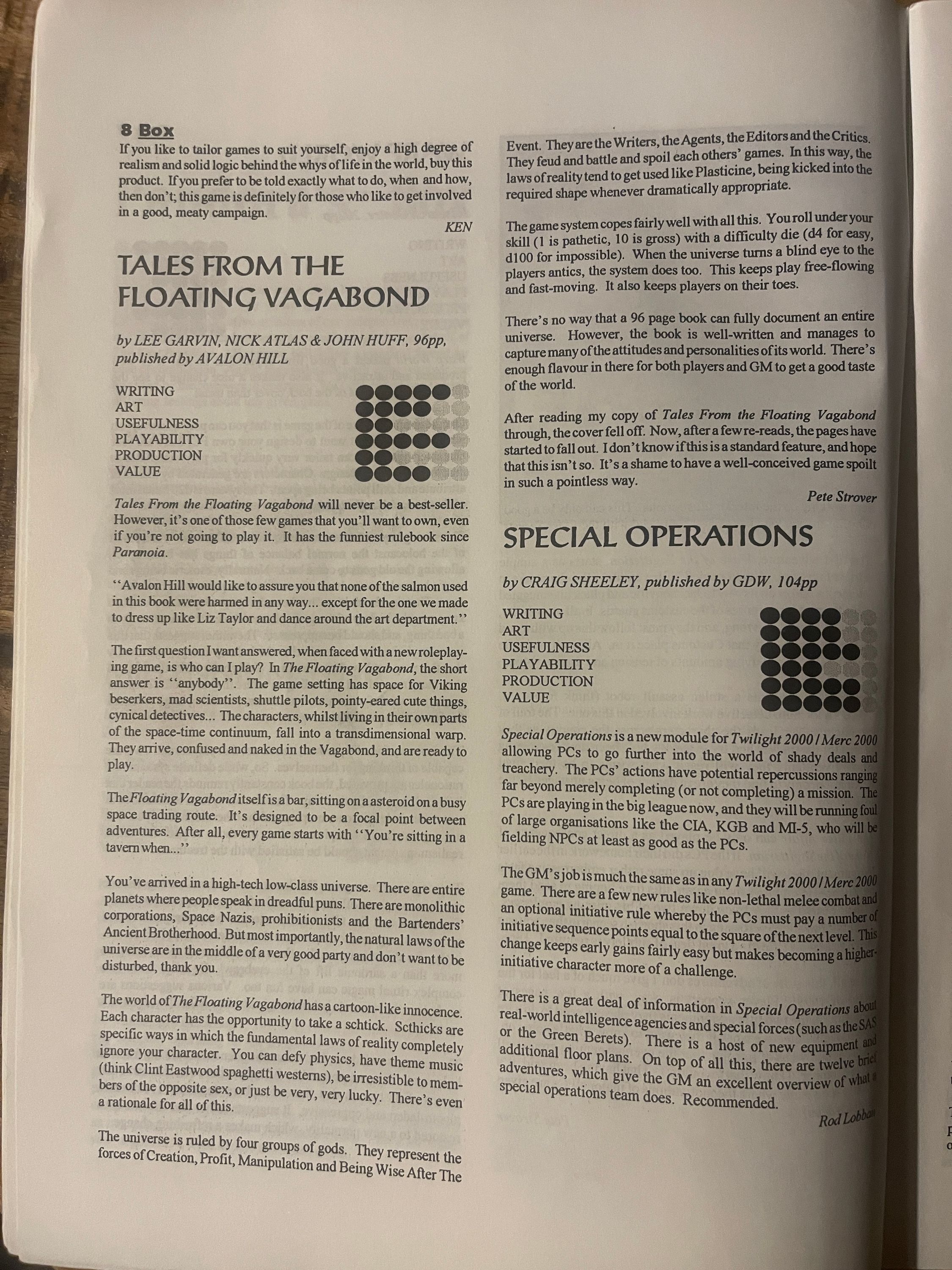
A review that gives a very high usefulness is Angus Boylan (The Art Editor, which is praise - the art is great in the magazine) who gave Werewolf - the Apocalypse a 6/6 for usefulness. The main reason seems to be that, in reading this, Angus discovered that he is Team Jacob, and likes werewolves more than vampires ‘or Leeches as the lupines call them’. In other words, the world that the game provides about these different creatures is so useful as to make any system almost irrelevant, and of that he gives only the briefest of allusions to.
The usefulness seems to be a measure of the “worlds” focus in any given text. For instance, the system-oriented Mythus gets a 3 for usefulness. This is a catgory I can get behind.
Art (over Writing?)
One of the things in reading through this magazine that I had cognitively known, but not fully felt before, was the impact of art. This review system’s mention of the ‘appropriateness’ of the art somehow struck a chord. This came partly from the review of Mythus Magick, the spell book for the newly released Mythus.
In this review, lupine fancier Angus Boylsn, talks about the spell descriptions as ‘usually dry and described in terms of game mechanics rather than how the spells are cast, and the rituals performed.’ This is coupled with ‘hardly any artwork to break up the monotony of page after page of spells.’ It gets a 2/6 for art, and a 3/6 for writing. But what he does like are the ‘very minor details’ that describe how mages must behave (‘being naked, bathing in salt water, or being seated in a pyramid which acts as a magic accumulator’). It seems this evocation of the world is the thing that Angus likes the most.
The Last Province properly showed how art achieves that. A lot of the “articles” or games/adventures are descriptions of worlds and people (not unlike a certain short-lived zine), for example De vere natura vis by Kay Dekker, is an in-character letter from a wizard to their colleagues on the development of some magic essence. This is a large block of small-fonted text, but it gains woodblock-style prints by Mike Middleton:
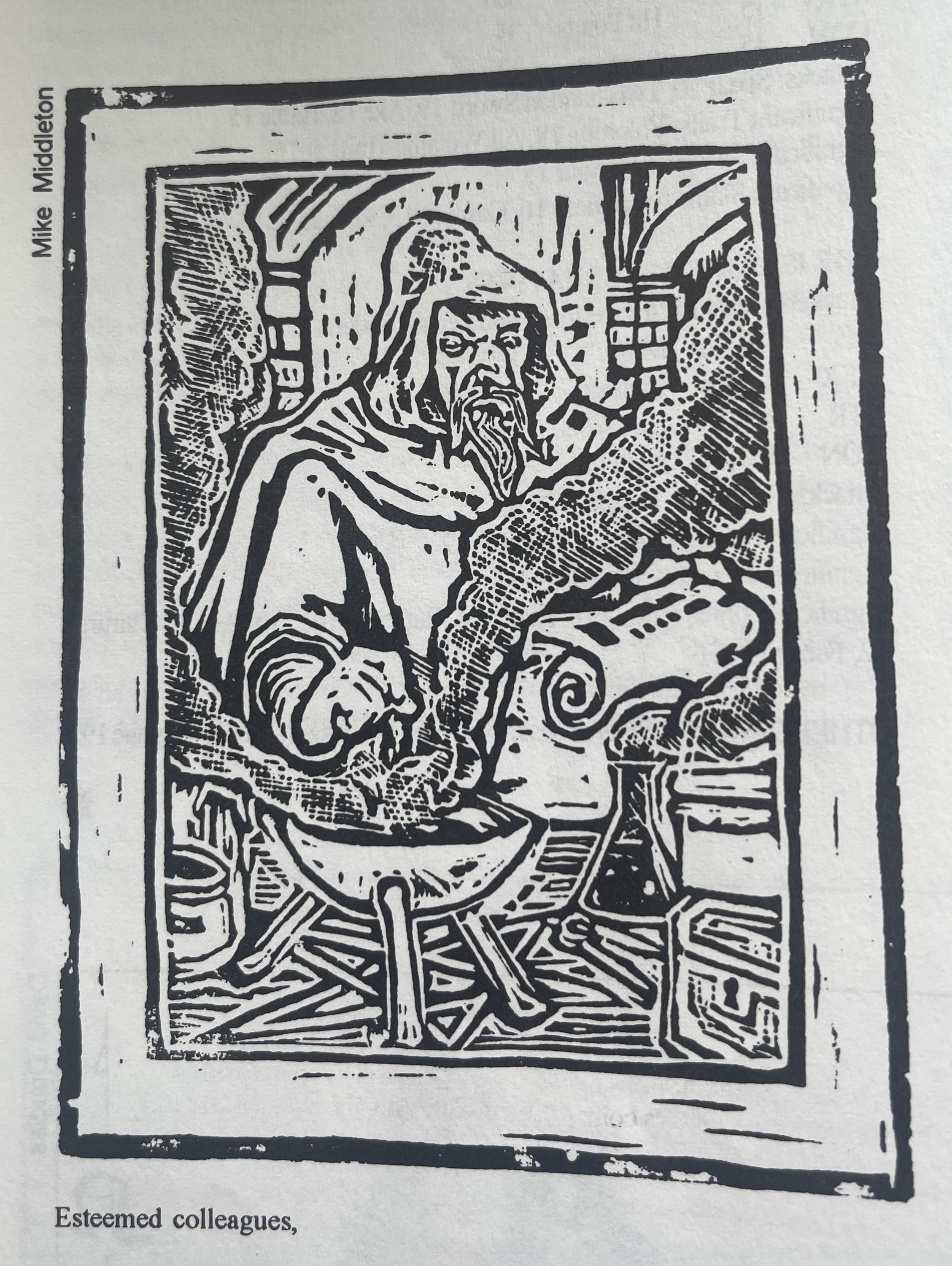 Call me a crackpot would you!?
Call me a crackpot would you!?
The “game” here is the world, the art is the shortcut into the text and is its evocation.
Another example comes from a scenario for Pendragon called And then there were Nun… by David Barras. This is a rather mundane adventure about knights escorting some young women to a nunnery. The magazine was published in 1992 and you can feel it in this adventure where the women are, um, not perhaps treated as well as they could be. At one point Isidore, in her husband’s armour, joins the knights: ‘if women of this type are common [i.e. female knights] play her as an intrusion, a needless weight around the neck of the party. They should be encouraged to feel protective towards her, in a typical patriarchal manner.’
Now lets look at the illustration of this character from David Brown:
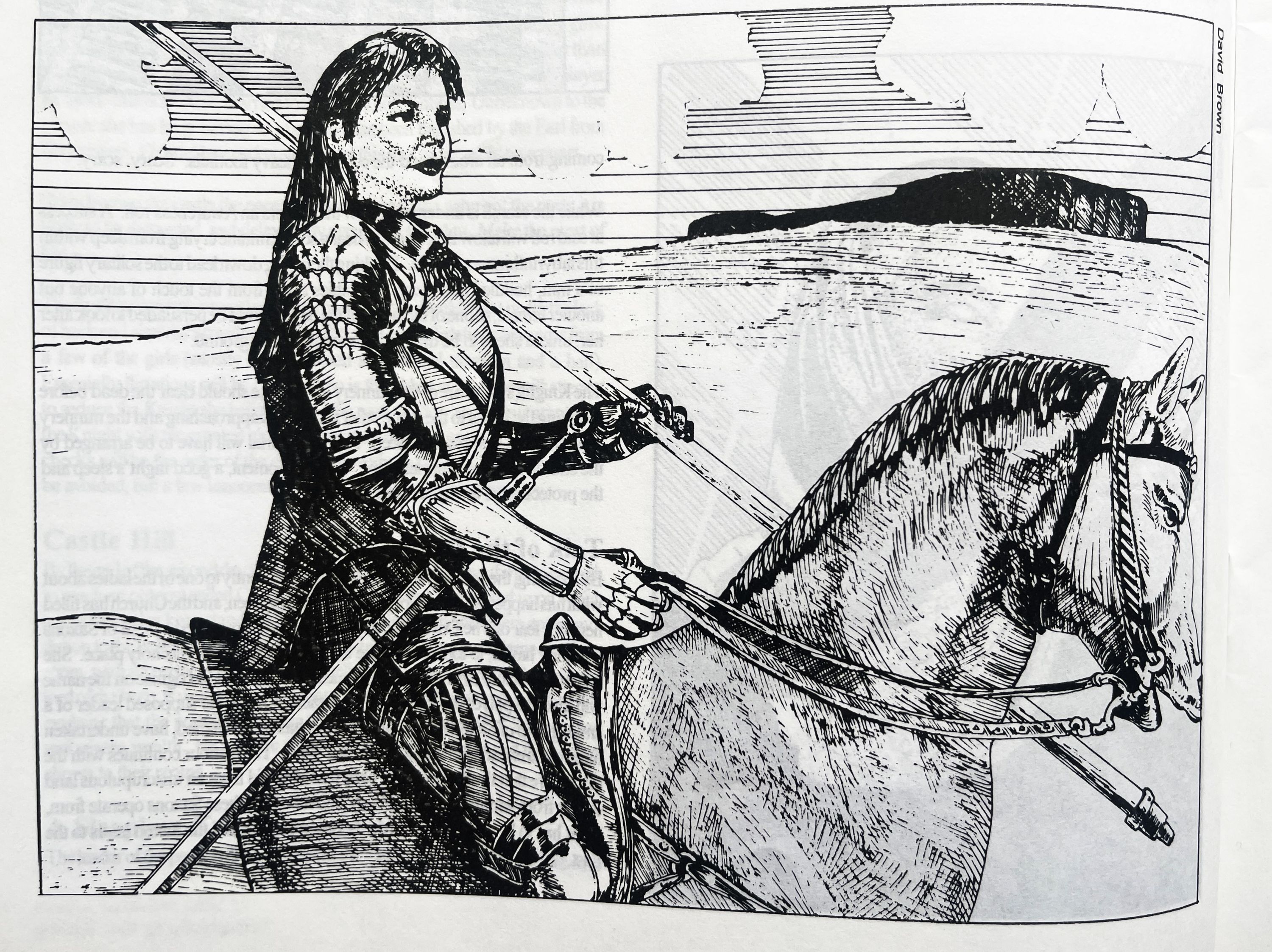
She looks like a fucking badass. Before I read the article I was like “this woman is going to be such a cool character”. The other art gives this really imposing sense of the darkness and danger of the scenario (the slaughter of a nunnery) which elevates the writing to something more. I personally feel that I could just take the pictures and run an adventure off of those and ignore the written adventure itself.
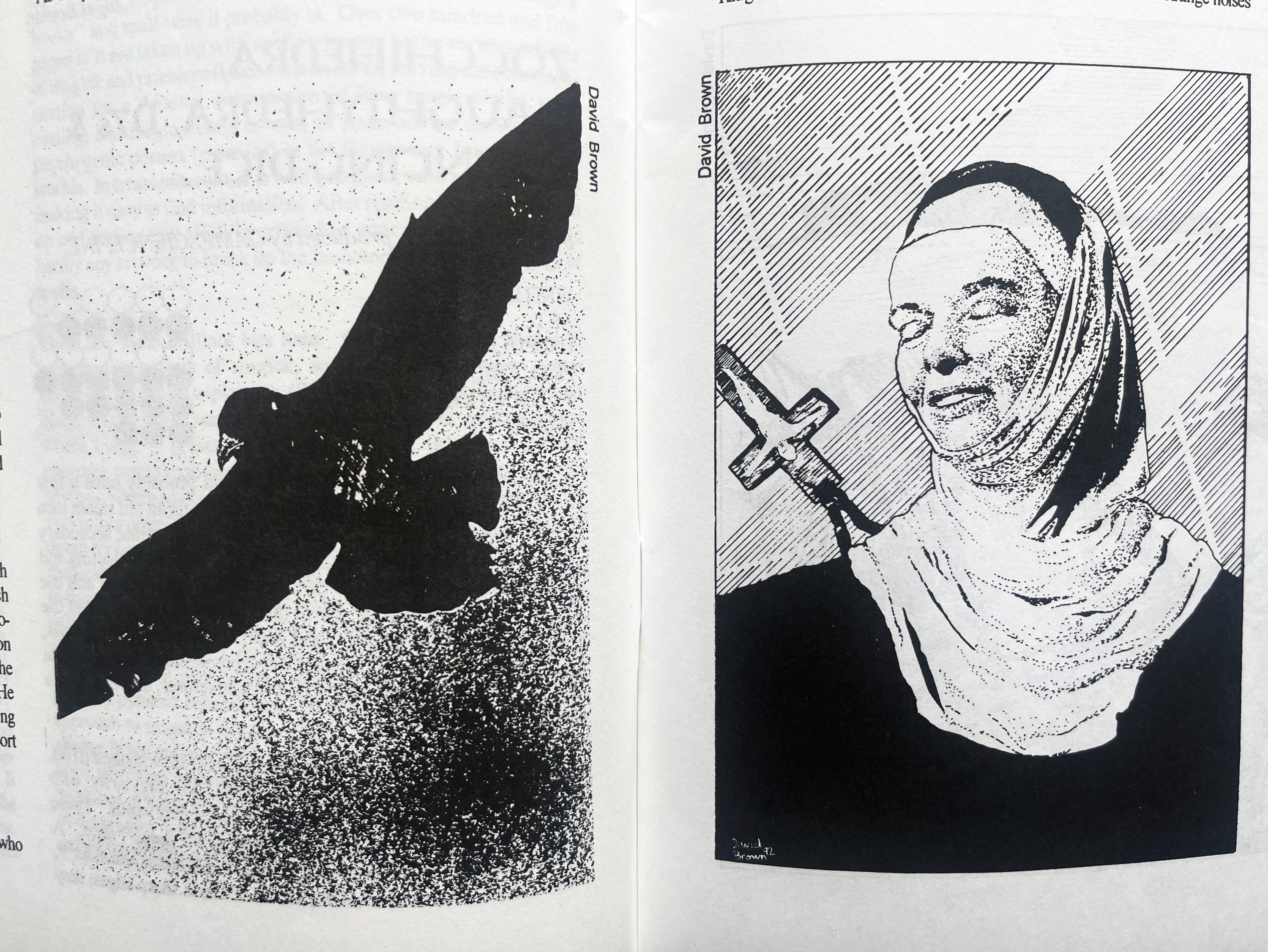
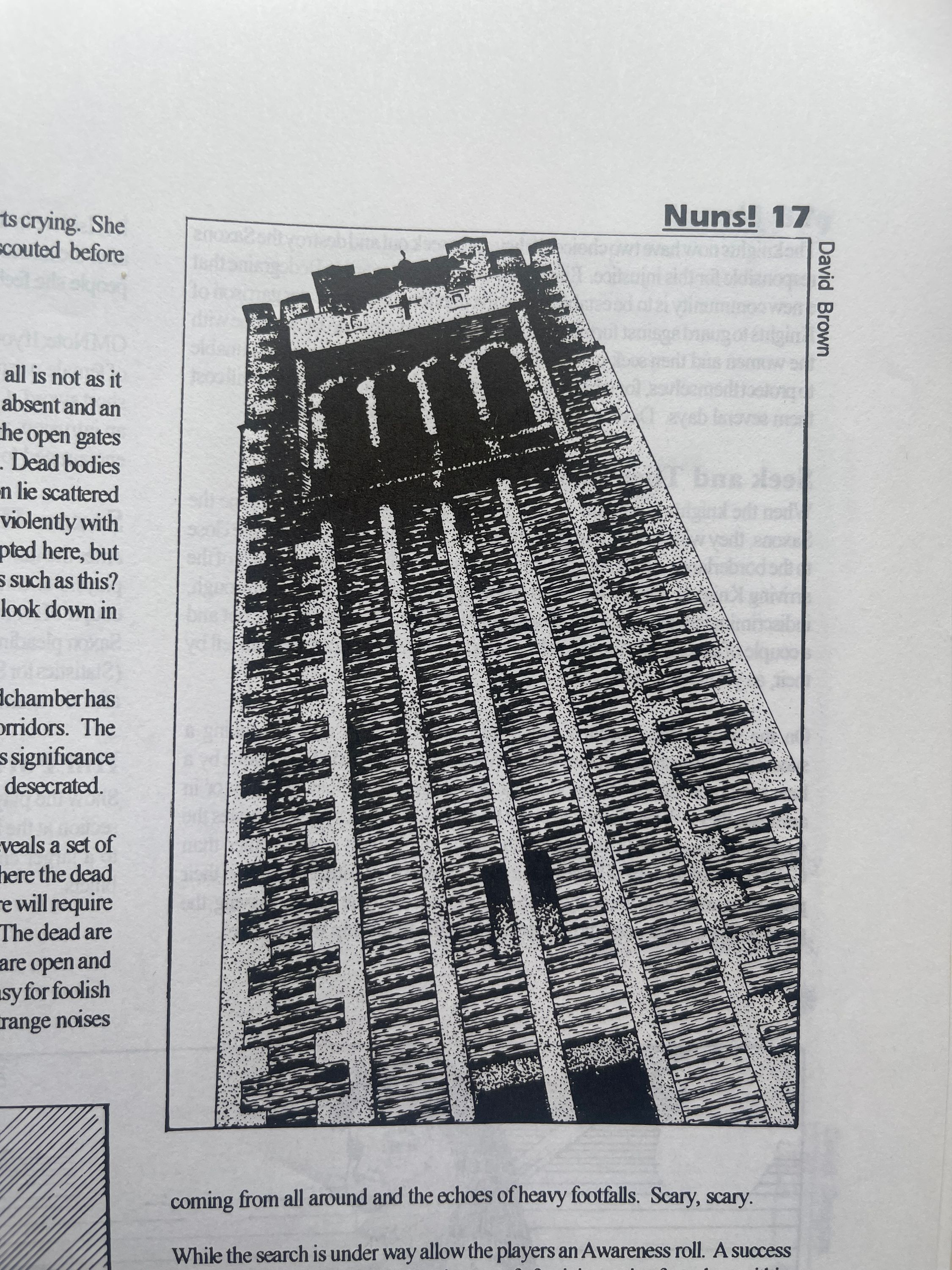
A sample review of And Then There Were Nun
- Writing: 2/6. Overlooking the sexism, the writing is fairly shallow though easy enough to read. It is both very rail-roady and not particularly evocative: ‘…strange noises coming from all around and the echoes of heavy footfalls. Scary, Scary.’ If you say so.
- Art: 5/6. A good range of images, from those evoking mood, others showing place and characters. There is also a pretty and simple map for one location. Another map or something similar would have been good for the nunnery, though the writing gives little inspiration for the reason for such a map. There’s also all this writing that gets in the way of the images.
- Usefulness: 3/6. The basic premise of the story would be interesting with a more nuanced treatment and more interesting motivations than “find the baddies, kill the baddies”. The art alone is what gives this its score.
- Playability: 1 or 4/6. It is a very simple adventure that if your players are used to very closely following only one route through a scenario would be easy to follow and lots of advice is given on how to get the players to the next scene. If your players in anyway want to scratch beneath the surface or take unexpected actions very little about the written adventure allows for that.
- Value: 1/6. The good part of the game is the art (and I have shown it here) otherwise, I wouldn’t hunt down an old gaming magazine just to get this. Though I picked up my £2.00 copy from Static Games and so having paid, I guess, 10p for its 4 pages, I can’t really complain.
Well there we go - maybe a useful guide for thinking about quality in RPGs, maybe, like most systems of evaluation, a way of dressing up subjective taste in the authoritative cloak of quantity.
Yours, The Wyrd
You can give me your thoughts, comments and follow what I’m doing on itch, twitter and tiktok!
Beginning Lino-cut: Simple art for RPGs
Lino-cut art is a relatively cheap, easy and effective way to produce art for a game or adventure module. This little guide shows you the steps I made in producing the back cover for FEUD with a suggestion of the times and costs. At the end I will include a simple list of tools and materials you might get to get started!
Step-by-Step
I am going to walk you through how I produced this image, used on the back cover of the FEUD zine:
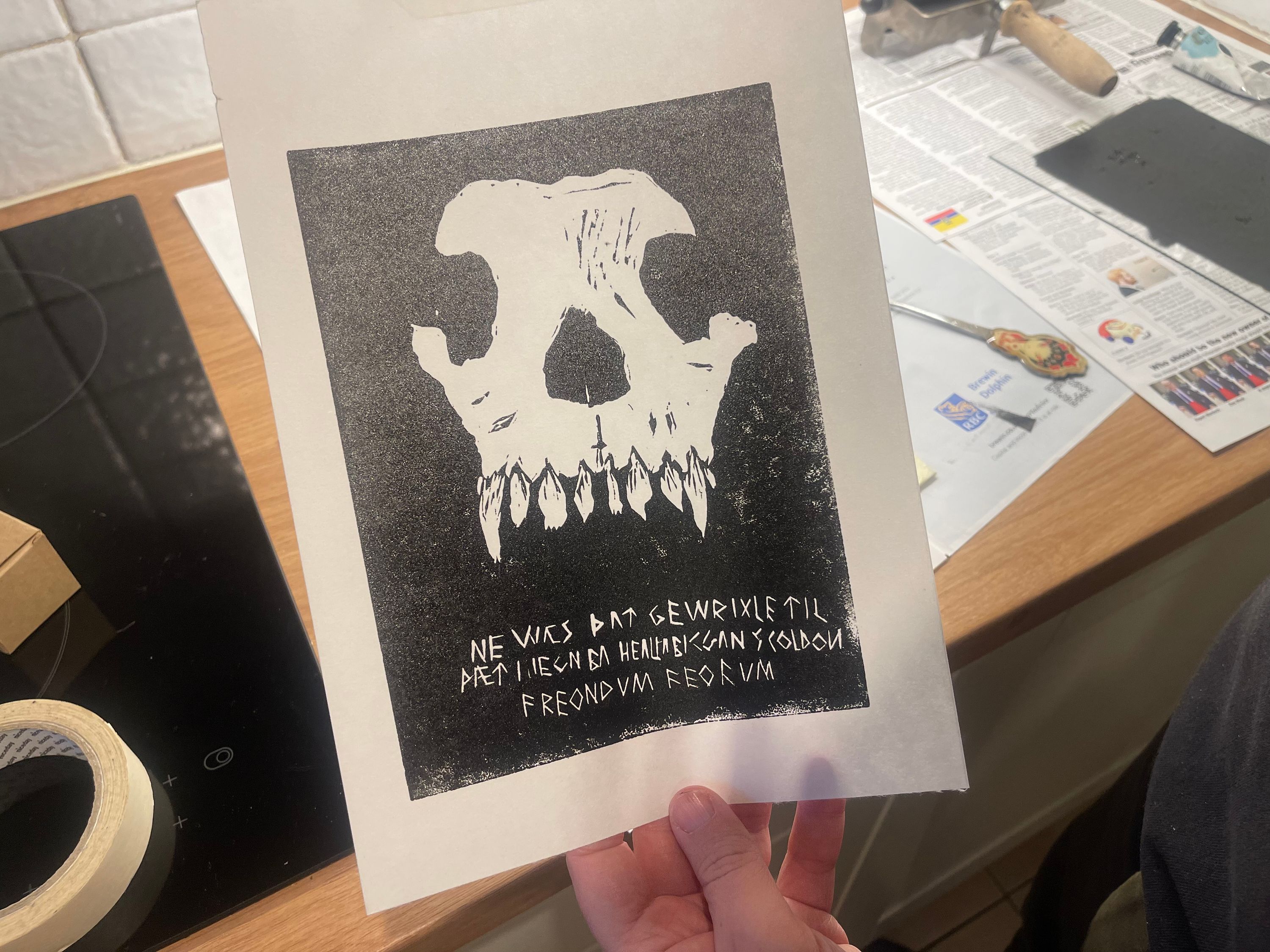
Draw the design.
Time: Approximately 4 hours, mostly while watching TV
Cost: Practically nothing, some paper and a pencil
This is potentially one of the most time-consuming parts and some people go far further on this than I do. I tend to be relatively rough and then use the lino itself as a canvas that I draw directly on to.
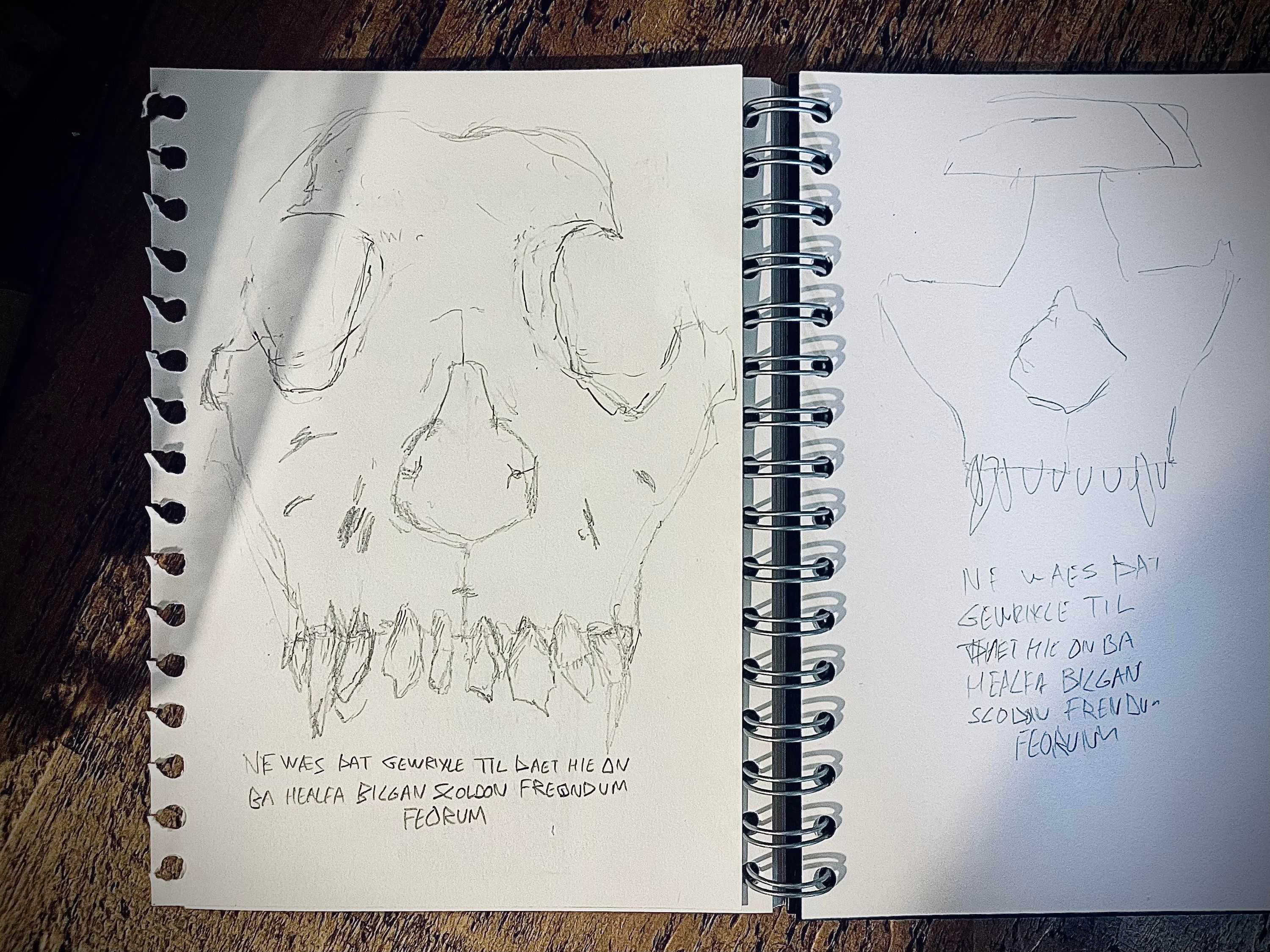
Transfer the design
Time: 10 minutes
Cost: The lino
Some people do exact designs and then transfer them using tracing/carbon paper. I am finding I enjoy things most when I use the lino itself as a form of canvas. In this case, I very roughly drew my design, knowing full well I would need to figure stuff out as I carved.
You’ll see my lino is pink, this is because its been painted with an acrylic ink that makes carving a bit easier. I find this helps, but it isn’t necessary.
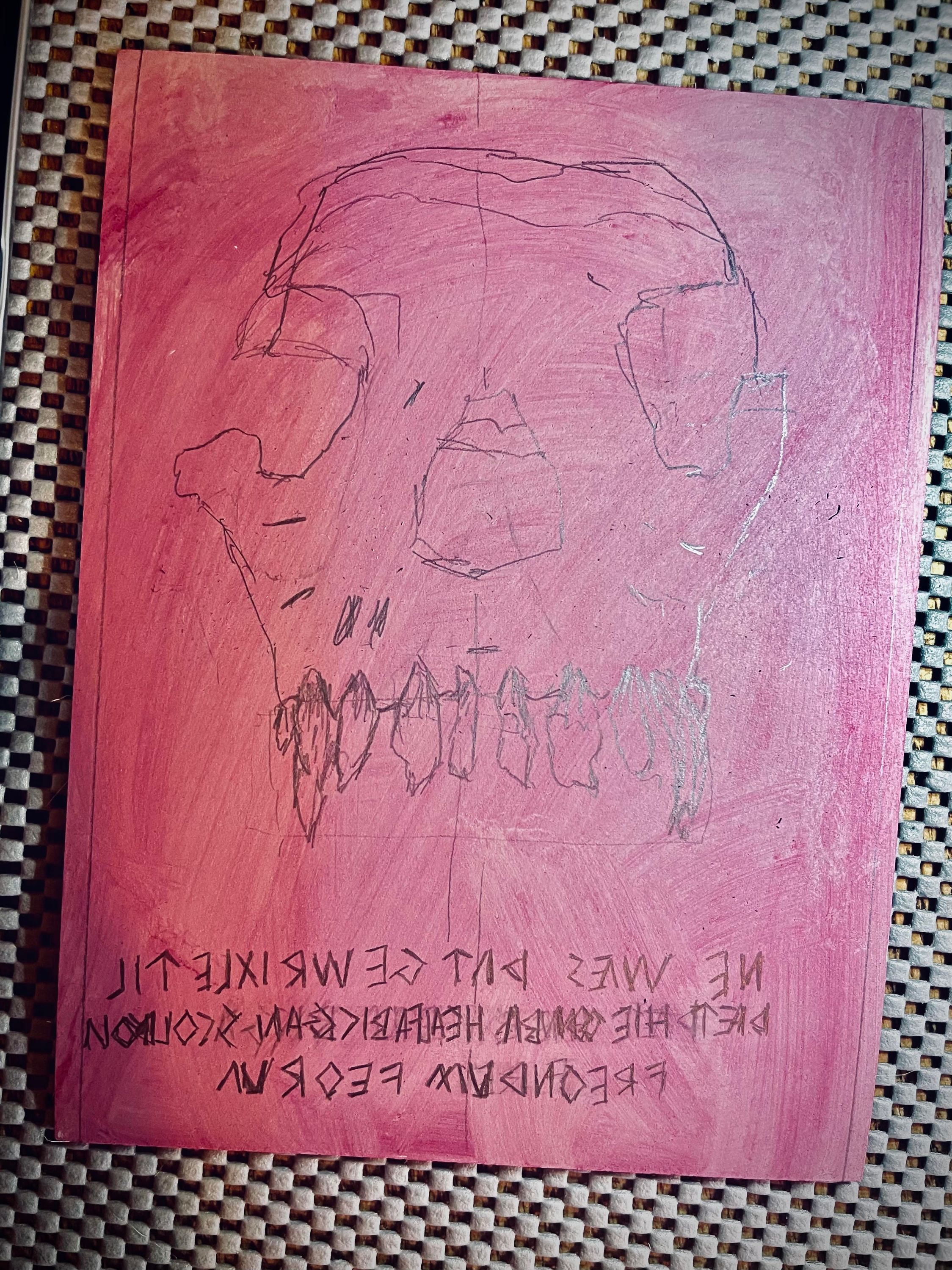
Carve
Time: 45 minutes Cost: The cutting tools
This is my favourite bit. There’s is something very fun about the immediate feedback of your use of the tools into the lino. I used two of the cutters here - a V mostly and then a U or curved one.
I start by cutting out the outline of the things I want to be white. I did this quite roughly with the V. The good thing about this tool is it isn’t designed for doing curves so when you try to do them them you get a very rough line, which is what I wanted here. The times here can really vary. This one took about 45 minutes, the longest I have spent is about 3 hours.

Then I cut away the majority with the round gouges, in some bits I do this quite shallow, so that ink will be more likely to accidentally touch and give some texture; and then deeper where I want that clear white.
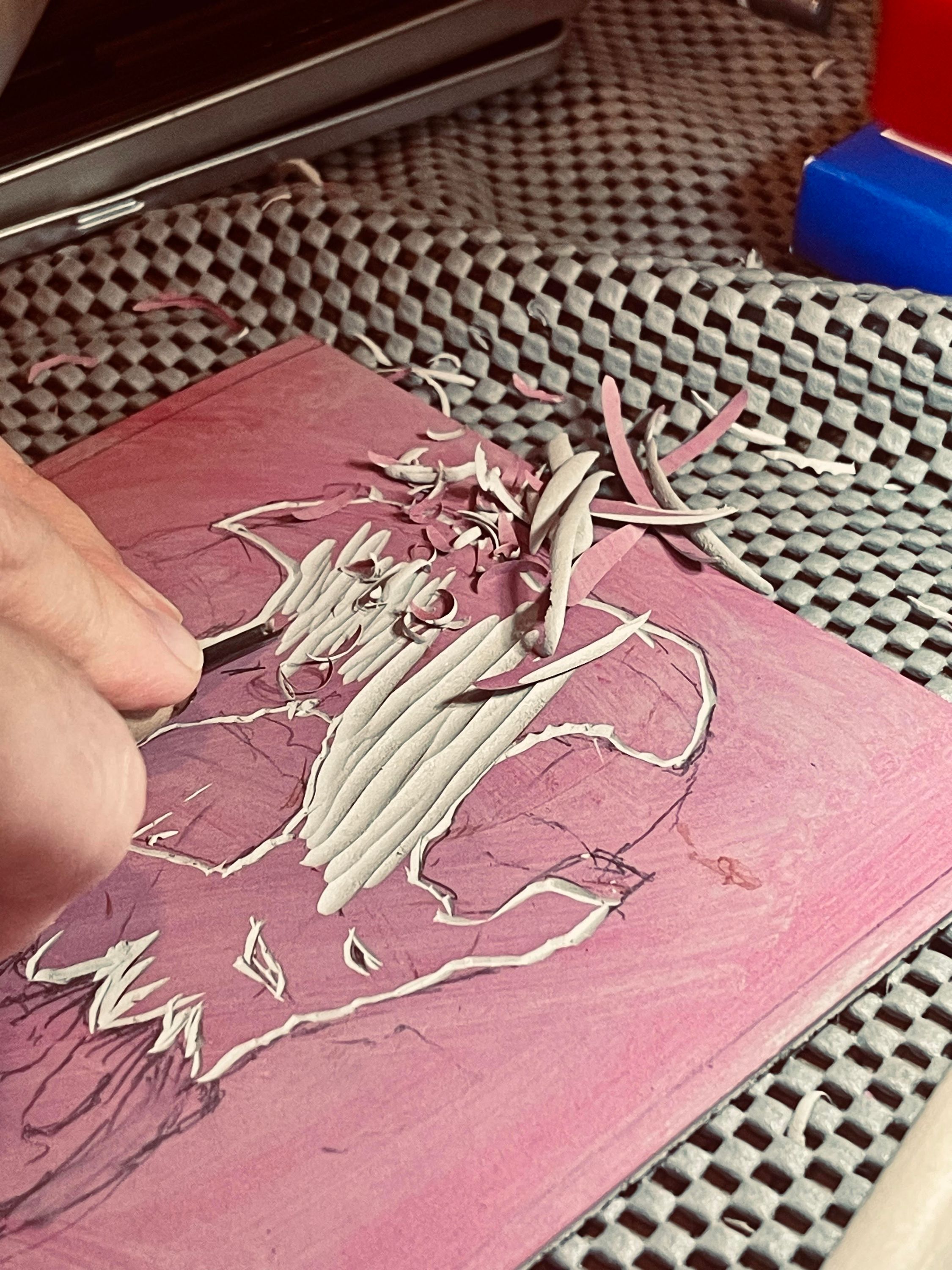
For the teeth I went back to the V and just cut away from the base quite roughly so they keep some darkness while the tips are deep. The lettering was the hardest part but not due to the carving but because I didn’t layout the text properly and everything got a bit squished.
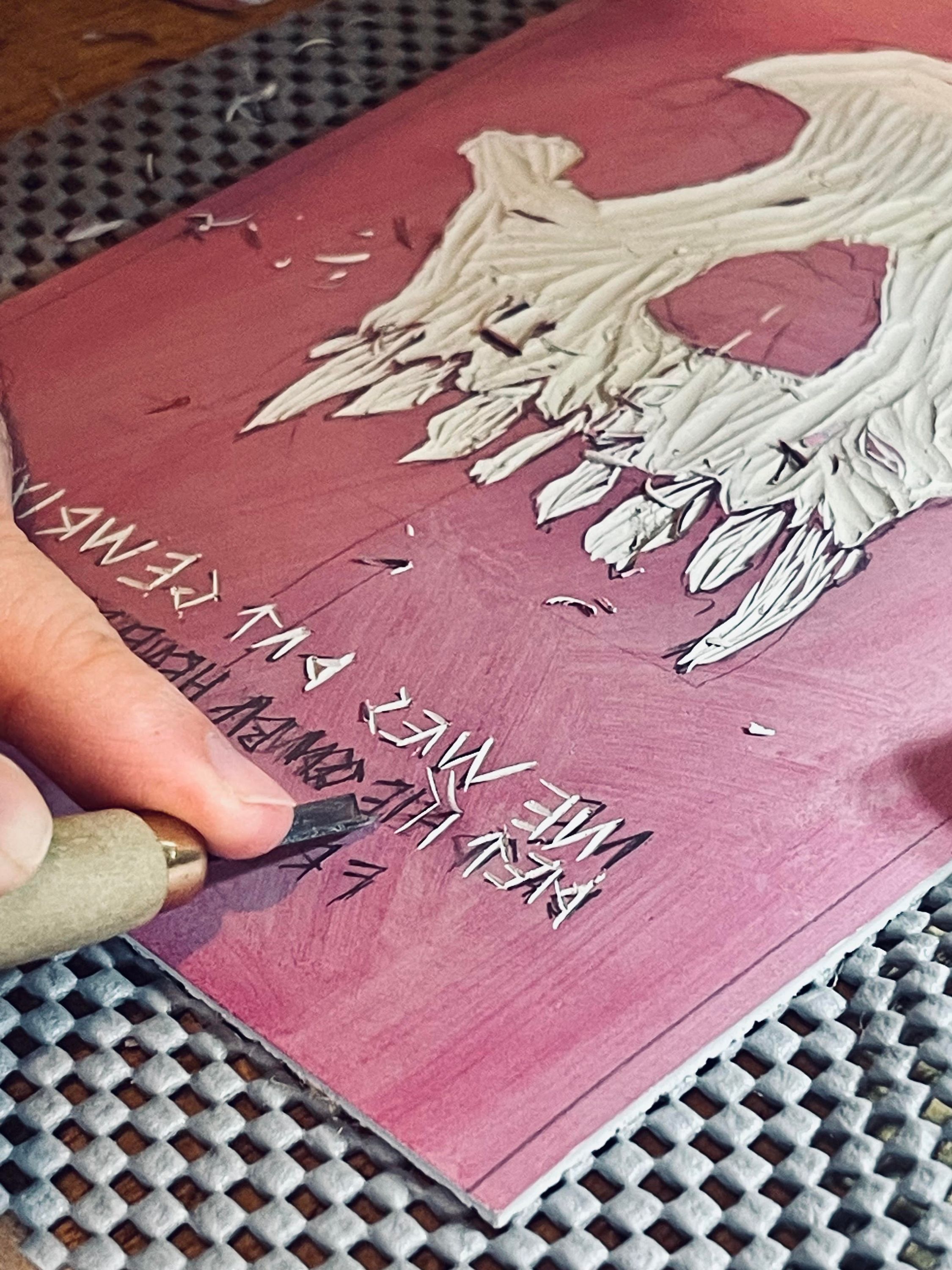
Print Prep/Test Print
Time: 30 minutes
Cost: The ink, paper and tools used to print.
Printing is the bit I find the most challenging and the kit is the most pricey. I have yet to learn enough to be able to mix inks or get consistent results. But this one is only black and white!
Here we start by setting out our kit and then inking up the roller - you put on a thinnish layer. When I started I didn’t do enough ink and so got bad results. I’m doing it slightly tacky and getting better results.
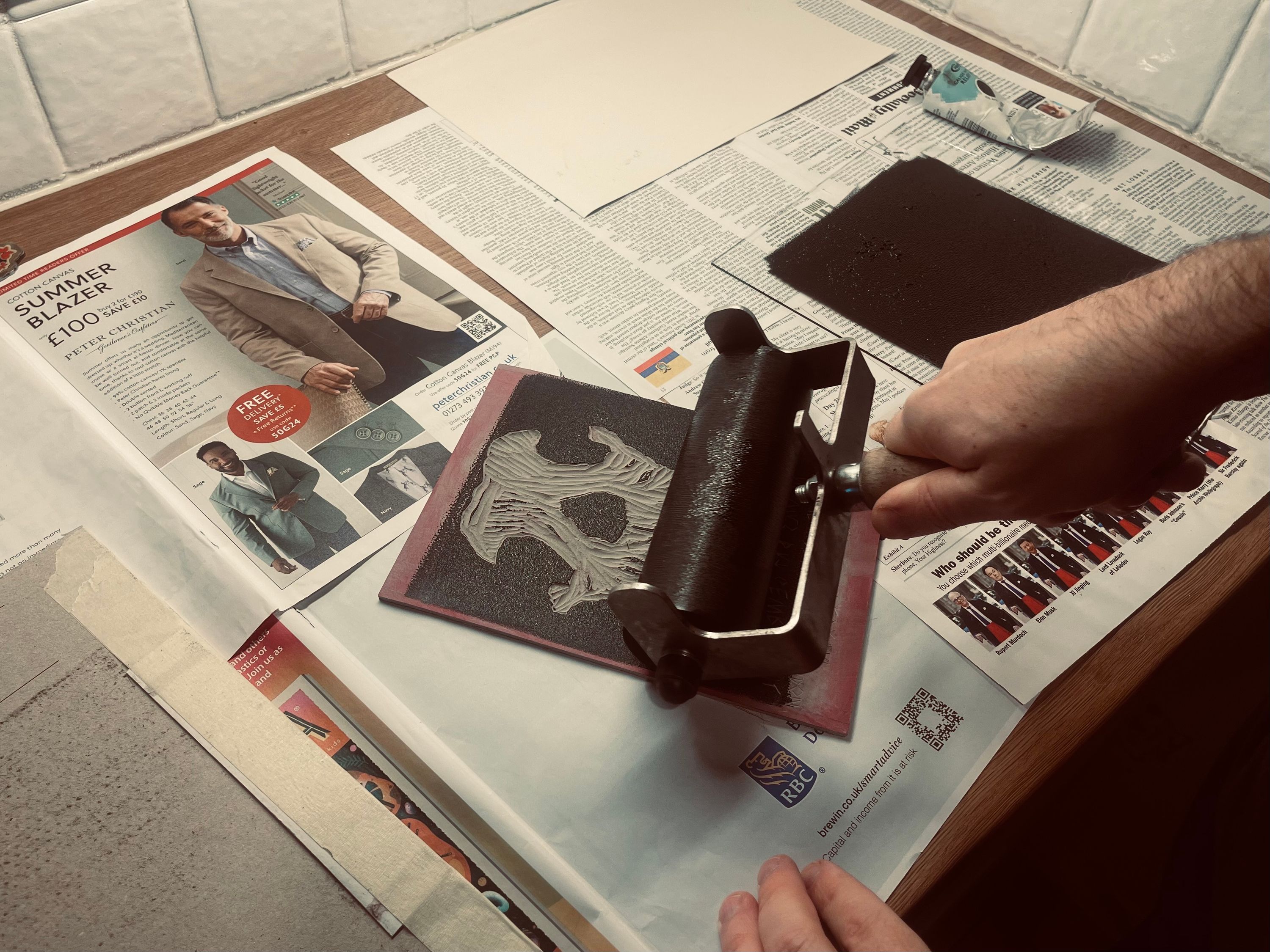
Then you can put them in a little frame called a registration board. Mine is cardboard held together with tape. This just helps to hold it in place when you’re printing and so you can line up your painting.
Put the paper on and then rub the back, here you can just see me using a spoon. It works great. Getting the knack of this stage is a bit tricky, and I have got to a point where I can get fairly consistent results. Probably got to a point where I was happy enough the second/third set of prints I did.
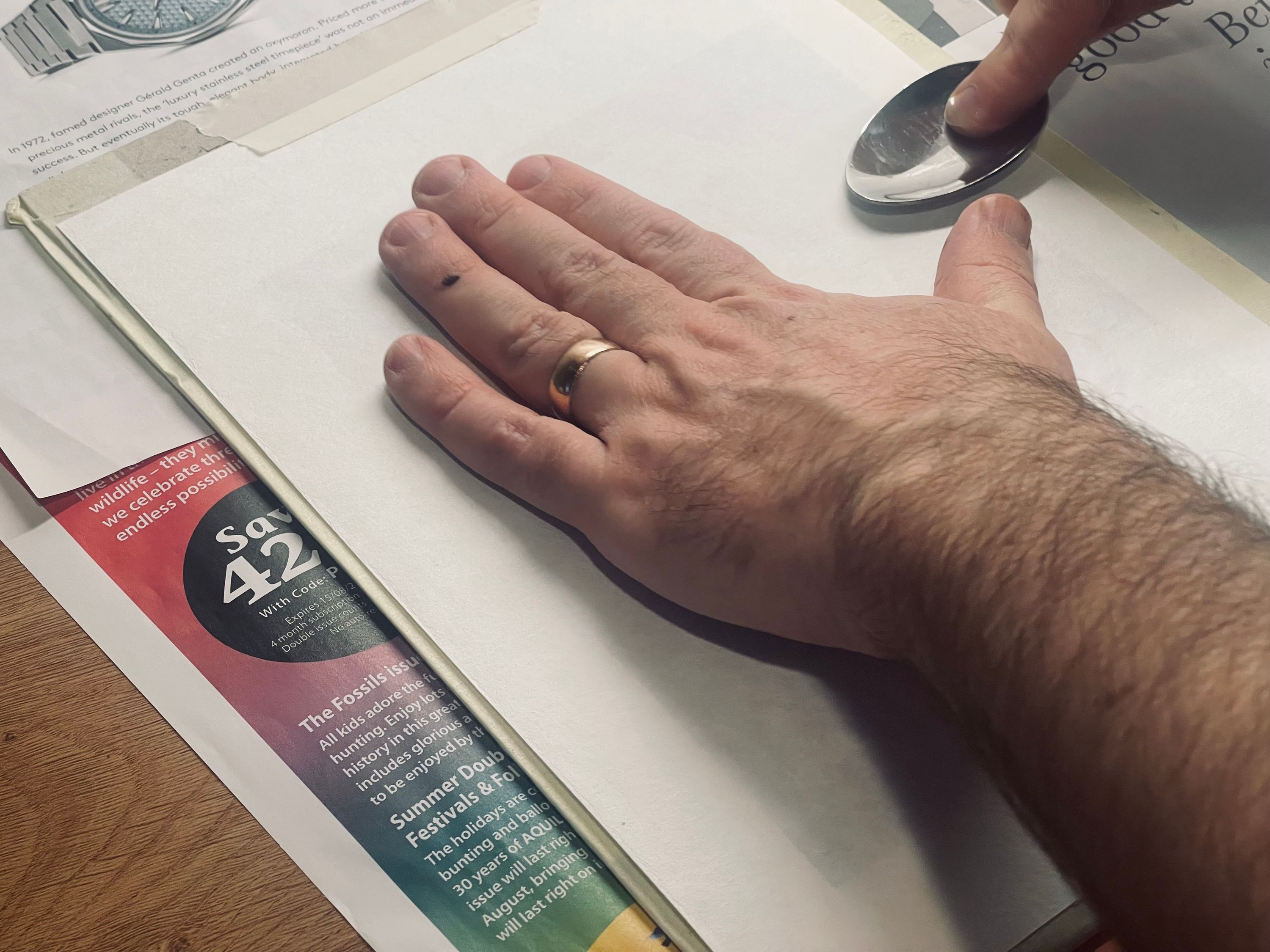
Peel it away - if you keep everything still you can peel, take a peek, and put it back if you want to re-print or even a sneaky extra bit of ink.
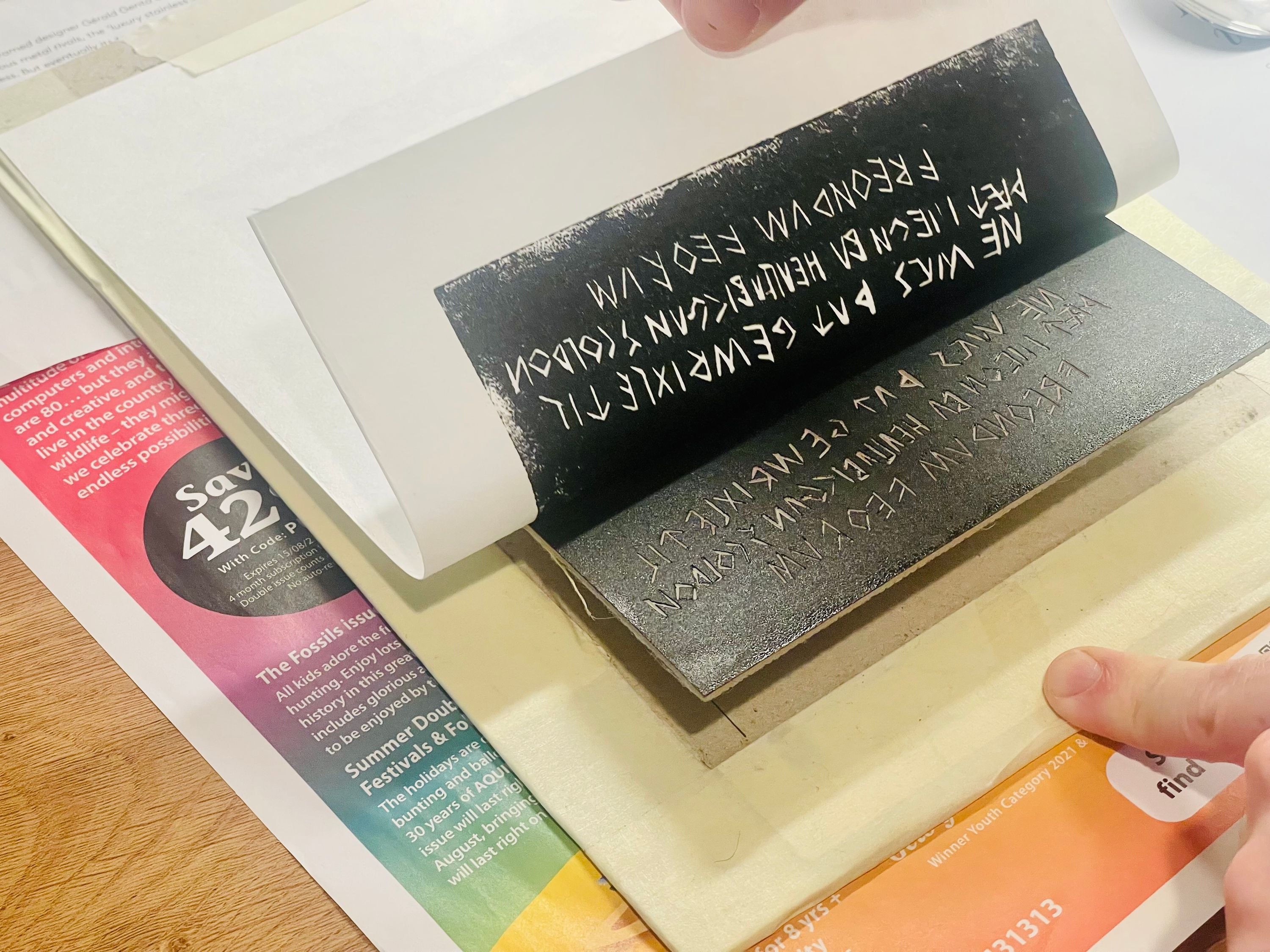
Then repeat and you’re done.

If you’re only looking to do this for art for your game you might repeat this till you get one key piece that you’re happy with.
Digitise
Time: 30+ minutes
Cost: your phone and editing software
This is the bit I need to work on next. Currently I take a photo on my phone and then edit it to reduce the saturation and then I delete the “white” in order to get an image just of the dark parts. I use Krita to do this but I need to either find a better way or buy a scanner. This works (and it is what I did for FEUD) but I felt it wasn’t consistent. I’ll take any advice that people have to offer.
Total
In total this print took around 5-6 hours, a lot of which was just coming up with the design hich i was doing while commuting, watchig TV, etc.
The cost additional to all the tools I already have is about £2.00 for the ink, paper and lino. I have spent about £50 on the tools i used for this. If you’re in the UK the site handprinted do a bundle for £44.00 that will get you printing straight away.
Tools and materials
Only a few tools materials are needed for lino-cut. In short we need the following two things: carving materials and printing materials.
Carving materials
Some knives: Here you can spend £4.00 or £125.00. The tools that the shop I am linking to here recommend are the £12.00 Japanese woodblock tools (which work on lino too). These have been fantastic for me - so much that you can get from these tools, and so much more. In particular there is one knife called a kiri dashi that I think is probably one of the most sophiticated tools if you spend the time to learn it. There are quite a few conflicting guides on how to use it but this manufacturer’s video shows it well.
Something to carve. At around £0.45 to £1.00 a sheet, lino is fairly cheap. I bought about 10 bigish pieces when I first started and that was enough to do all the art for FEUD.
I also bought a bottle of acrylic ink for about £3.50 in an art supply store. You can use a little to stain the lino and it makes cutting a lot easier. Regular cheap acrylic paint works for this too.
Something to lean on. I use a bit of an “anti-slip” mat for drawers (this kind of stuff) to rest on when I carve. You put a lot of pressure into the lino and you don’t want it to slip. Bench hooks exist if you have flat-edged tables (I don’t).
Light. Just bright light makes things easier, big windows, torch on your phone, a work lamp etc. I have a fantastic set-up of a phone tripod with this cheap light from a homeware store.
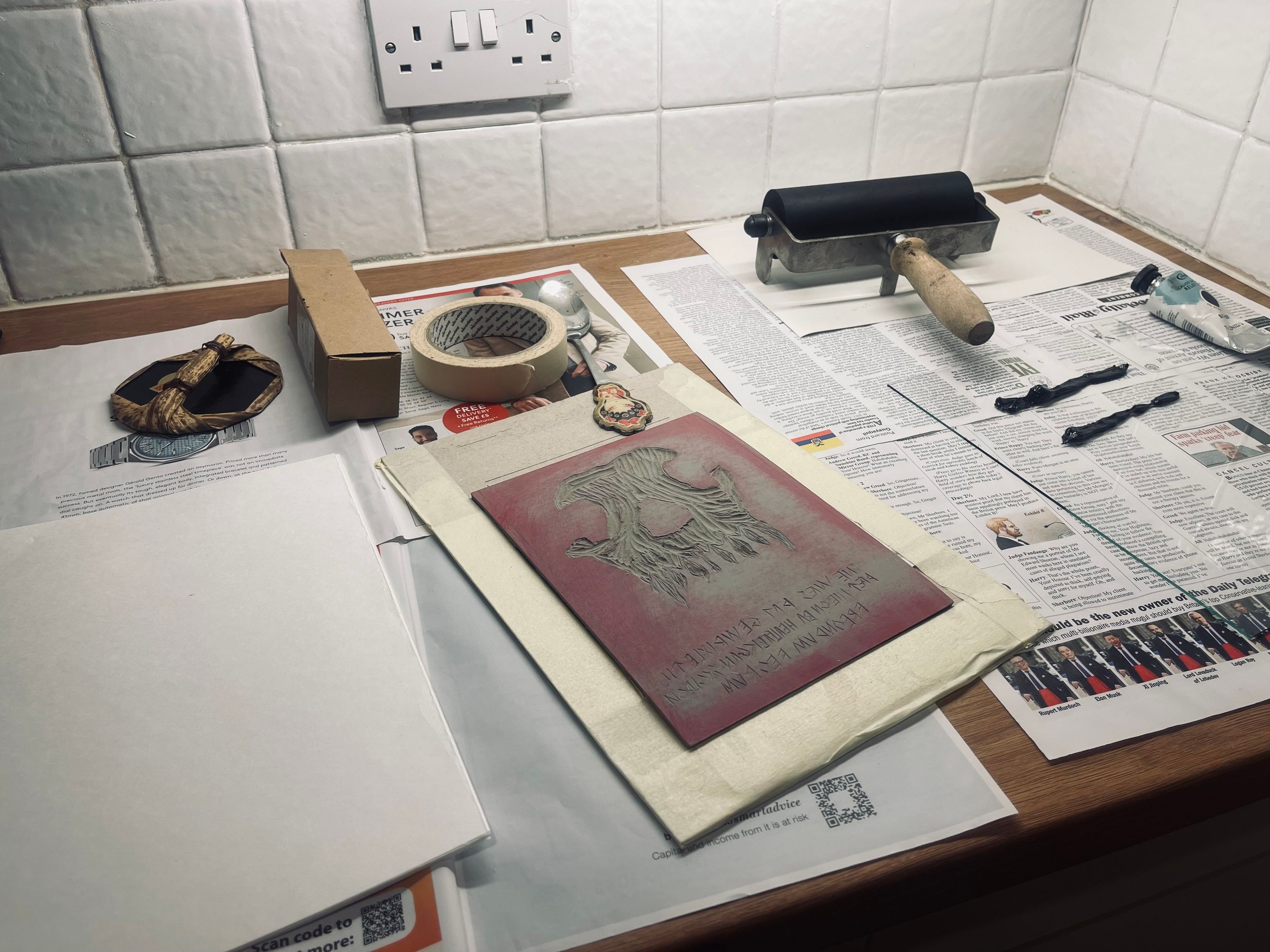
Printing Materials
Ink. I bought one £8.00 tube of burnt umber that I have barely made a dent on in producing around 80 prints. I have found this ink great so far and my next steps will be to experiment further with colours and more sophisticated, multi-layer prints.
Roller. The basic “blue” rollers are great at around £9.00. I ended up getting a fancier one which I love but I didn’t really need. Basically I wasn’t using enough ink but I thought it was the roller’s fault.
Paper. The paper! SO beautiful some of it. I bought this Hosho paper pad for £18.50 and I have some more straightforward paper for testing and when I want a more uniform result etc. The Hosho paper did all of my prints, I have loads left and creates this lovely textured effect in the print. There are all different types you can get, and experimenting to choose the right one is going to be a fun past time over the coming years.
“Press”. I use this simple barren for £3.95 and the back of a metal spoon. Really the spoon alone would do!
There we go! I highly recommend trying lino-cut if you want to produce art for your game and can’t afford to pay someone. It is fairly easy to learn, and though it does require some time, the results are great. Lino cuts automatically create this strong expressive style that can be great.
You can give me your thoughts, comments and follow what I’m doing on itch, twitter and tiktok!
If you’re on Discord I also mostly hang out on the FKR Collective and NSR Cauldron.
Defining good roleplaying; or, How to play Horsey
What is good roleplaying? This is a question that doesn’t get explicitly discussed nearly as much as the near endless discourse on “what is good X roleplaying”. For X substitute your name/label/acronym of choice: Horsey/OSR/NSR/FKR/Trad/Story/5e/lyric/etc.
Why is there this disparity in what people talk about? Without getting lost in the weeds of human desire for categorisation, I am going to take the line that people talk about “how to play Horsey” as opposed to “how to play” because the latter has an incredibly obvious answer and potentially one that actually invalidates the former. I’ll get to my answer after I take a running leap off the spring board of yet another interesting post by Weird Writer.
In the post Weird was writing against a specific set of statements that an original author was trying to present as objective features of OSR. These statements, along the lines of “we explore dungeons, not characters,” Weird clearly demonstrates are not inherent in the aesthetic/products/community of OSR. Instead they suggest that the original author is engaging in that common trope of conflating their own personal tastes with the definition of a term: “what I like = OSR”.
This is the logic of how to play horsey: “I like to play Horsey this way = this is how you play Horsey”.
 How it feels when people play horsey wrong (Bing AI art crap)
How it feels when people play horsey wrong (Bing AI art crap)
I would suggest that one of the reasons why we as the ttrpg community engage so frequently in discussions of what a thing is or isn’t, is because our emotional investment in an idea. At times that becomes strong enough that we begin to conflate the genre/aesthetic of an acronym with our view of what good roleplaying universally is: “what I like = OSR = good roleplaying”.
We’re getting a little closer to my answer for what good roleplaying is but I want to get there by describing where I got it from.
In the earlier days of the application of free kriegspiel to roleplaying, there was an evocative sense of promise. This emerged from its general approach to “hard mechanics”, that is resolution systems, character sheets, stats, moves etc. This approach, and the promise, was that: ‘you only need to use the mechanics that are needed at the moment that they are needed’.
This is a freeing idea. It draws us out of the adherence to labelled/acronymised systems, games or playstyles. It pushes us to see that play is the centre of the experience and the way that we play, the how/tools/mechanics, is a product of the table of players in the moment. The game we play is not pre-ordained but is being generated in the moment of play.
Free kriegspiel perhaps gives us more than this, but I would suggest it is the main thing. Even some of its associated ideas such as “play worlds” are almost a natural conclusion of the introduction of freedom into the relationship with mechanics: If you can’t rely on the published/pre-written rules, you can rely on the rules of the shared imaginative world.
There used to be a sense of excitement about this idea, that pushed one towards an even broader idea. A definition, if you will, of what good roleplaying is: good roleplaying is playing the way the table wants to play.
There it is. My answer to the definition of good roleplaying. If it is in any respect true you can see why people never talk about it and instead talk about how to roleplay in X style. There is very little to say about “play how you want to play”. What this suggests to me then is that discussions of definitions of types of play (Horsey/Ponies/Unicorns/OSR/etc.) are engaged in because it is a way of interacting with the freedom and openness of play in a way that can be argued, discussed and (perhaps at worst) made objective. By talking definitions we are in fact engaging with the general discussion of how I as an individual enjoy playing in a certain style: “I like to play like this = this is Horsey”.
 How it feels when people play Horsey right (More Bing stuff)
How it feels when people play Horsey right (More Bing stuff)
The value of this understanding to me touches on a couple of things. The first is that I find I can always get something from peoples’ different definitions because I never feel they are talking about a real thing in the world, they are only talking about themselves; the second is it highlights again, as does so much in life, how useless a lot of labels are. I feel that what people are really saying when “we play 5e” is “we play in this way”. There is no way for me to know what “this way” really entails until I sit down to play with that group. I have played games that called themselves OSR that have made me want to die of boredom and others that have matched my tastes exactly.
My conclusion is then, that debating the definitions of things is simply another way for people to discuss how they like to play horsey. People write “good X is Y” or “proper X is Y” but they are really always saying “I like to play horsey this way”. And, if we want to learn new and interesting ways of playing horsey then debate and disagreement is simultaneously potentially valuable to oneself as an individual, and utterly meaningless to any true or external definition.
PS
When I have made this point in the past it has been suggested that without strong definitions dialogue breaks down and becomes impossible. Though I personally think I have seen the opposite far more — that adherence to definitions interrupts dialogue — the sentiment is clearly true for a lot of people.
Itch: thewyrd.itch.io Twitter: @TheWyrdLands TikTok: @TheWyrdLands Email: wyrdrpgs@gmail.com
FEUD - Cairn Adaptation
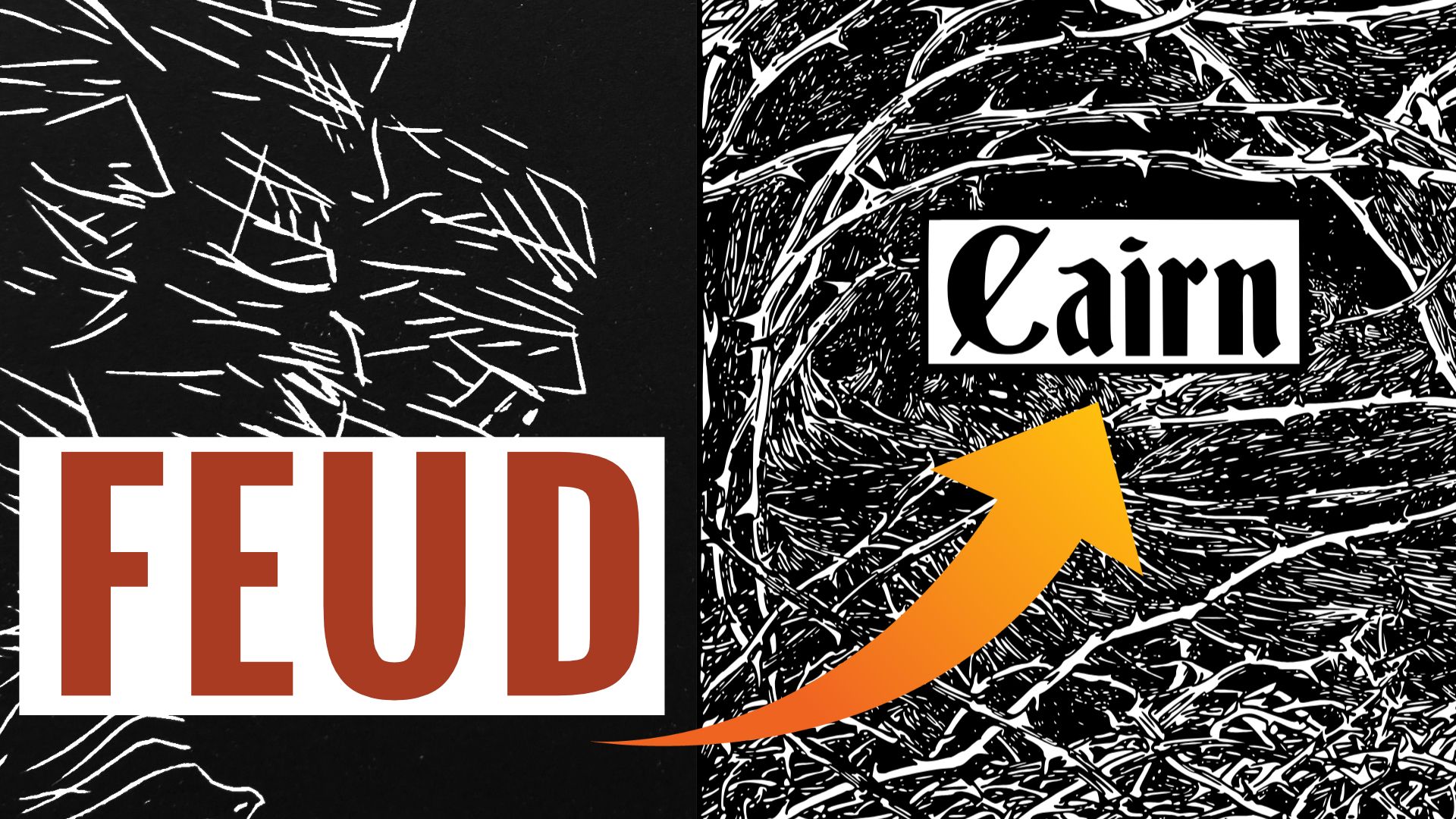
Below is an adaptation of FEUD to Cairn first edition. It goes from character creation to some monsters and NPCs.
Anything that is unchanged from the original is to be used as is.
Character Creation
If you wish your characters to be from the region itself, keep the same except for starting gear and below. Each character starts with access to as much food as they need and other tools that might be lent to them by their community.
If you wish your characters to be wandering adventurers, keep everything the same except for the below.
Name and Background
| Backgrounds (d12) | . | . | . |
|---|---|---|---|
| 1. Mot (Wrath) | 6. Karl (Human) | 11. Ful (Foul) | 16. Hvitr (White) |
| 2. Jofur (Boar) | 7. Vig (Battle) | 12. Vor (Vigilant) | 17. Mers (Fame) |
| 3. Bane (Bane) | 8. Wis (Wisdom) | 13. Nand (Daring) | 18. Leud (Spear) |
| 4. Uul (Temple) | 9. Leifr (Heir) | 14. Hialm (Helm) | 19. Aud (War) |
| 5. Geb (Gift) | 10. Arn (Eagle) | 15. Rafn (Raven) | 20. Valdr (Ruler) |
Roll once on the table above for a single name, twice to join the names together. Use either the original or “translated” word. E.g 1 and 5 is ‘Mot-geb’ or ‘Wrath Gift’.
| Backgrounds (d12) | . | . | . |
|---|---|---|---|
| 1. Herbalist | 4. Raider | 7. Farmer | 10. Priest |
| 2. Smith | 5. Shaman | 8. Justice | 11. Witch |
| 3. Forester | 6. Hunter | 9. Poet | 12. Trader |
Starting Gear (d20)
| Armour | . | . | . |
|---|---|---|---|
| 1-11 | 12-17 | 18-9 | 20 |
| Cloth | Thickened Cloth | Mail patches | Mail shirt |
| Shield and helmet | . | . | . |
|---|---|---|---|
| 1-10 | 11-16 | 17-9 | 20 |
| Old, cumbersome Shield and hood | Unwieldy shield and hood | Shield and thick cloth cap | Balanced shield and metal helm |
| Weapons | . | . |
|---|---|---|
| 1-11 | 12-17 | 18-20 |
| Roll once on table below | Roll twice | Roll three times |
| Weapons | . | . | . |
|---|---|---|---|
| 1. Ugly and awkward mallet | 6. Worn but dependable spear | 11. dull and awkward war axe | 16. Frail but elegant bow |
| 2. Frail wood axe | 7. Frail spear | 12. Worn bow | 17. Strong bow |
| 3. Old and bulky spear | 8. Refined spear | 13. Old but beautiful long knife | 18. Unbalanced long axe |
| 4. Tough but bulky mallet | 9. Bone pick | 14. Frail old sword | 19. Tough, ancestral spear |
| 5. Balanced wood axe | 10. Unwieldy and weak spear | 15. Tough war axe | 20. ugly old long knife |
There is a perchance generator for generating arms and armour in the world of FEUD.
| Expeditionary Gear | . | . | . |
|---|---|---|---|
| 1. Yard of cloth | 6. Herbal elixir | 11. Stone Maul | 16. Satchels |
| 2. String | 7. Poisonous herbs | 12. Stinking herbs | 17. Bladder |
| 3. Protective Amulet | 8. Long staff | 13. Trapping tools | 18. Cursing amulet |
| 4. Tinder | 9. Bone pick | 14. Wood spade | 19. Animal parts |
| 5. Herbal poultice | 10. Dowsing rod | 15. Household knife | 20. Wood whistle |
| Tools | . | . | . |
|---|---|---|---|
| 1. Bellows | 6. Clay pot | 11. Egg lubricant | 16. Net |
| 2. Carved bucket | 7. Bone/wood lever | 12. Stone hammer | 17. Small handaxe |
| 3. Animal teeth | 8. Awl | 13. Farming tool | 18. Plant resin |
| 4. Chalk/Stone | 9. Fishing rod | 14. Scraper | 19. Hoe |
| 5. Bone chisel | 10. Animal glue | 15. Wooden pins | 20. Wood tongs |
| Trinkets | . | . | . |
|---|---|---|---|
| 1. Clay bottle | 6. Horn | 11. Polished metal | 16. Dried entrails |
| 2. Playing pieces | 7. Metal bracelet | 12. Natural scents | 17. Knuckle bones |
| 3. Dice | 8. Rattle | 13. Witch stones | 18. Broch pin |
| 4. Face paints | 9. Wash cloths | 14. Salt | 19. Hair band |
| 5. Plant Bracelet | 10. Wood marbles | 15. Noise maker | 20. Comb |
Spellbooks
Most of these spellbooks should not be used. Those that can be specifically skinned as have an origin in the world of spirits or humans may be kept. That is, things that are “clearly magical” should be avoided. For example, telepathy or Summon Cube would not be appropriate, where Pacify and Hatred may be interpreted as the result of a poet’s wit or a hunter’s personality.
Prices and Equipment list
Gold and currency is not something that exists in the world of FEUD. Where things have a relative value the values given should be seen as a “category of value” that may have an effect in trade and bartering. For example, an object work 5 may be traded for another of similar value.
However, it is unlikely that these opportunities for trade will arise too often. Therefore you will have to rely on your neighbours who may loan you items, or you may have access to shared/communal equipment.
Monsters
The Alone
1 HP, 2 Str, 3 Dex, 5 Wil
- They appear to be humans who awake in the waters of Leoth’s swamp, choking and lost.
- Cannot be damaged by mundane weapons, are instantly obliterated by sunlight or fire light.
- Can talk and are knowledgeable of the spirits, gods and monsters of this region.
Foe-Spirits
2 HP, 6 Str, 15 Dex, X Wil
- Trickster spirits darting between the ancient trees, appearing as frightening visions depending on the viewer.
- Cannot be damaged by mundane weapons.
- Terrify: A PC exposed to a Foe Spirit must make a WIL save or be frightened or stunned.
Feorhnu’s Blood
12 HP, 2 Armor, 14 Str, 15 Dex, 18 Wil, Mistletoe boughs (d12)
- By day a woman’s body stuffed in an oak tree, by night a humanoid mass of shambling mistletoe, trying to regain her humanity.
- Feorhnu’s Blood will regrow after her death.
- Those who possess Feorhnu’s hand can communicate with this monster and learn her knowledge of the people and gods of this land.
Humans
Göt Warriors
4 HP, 1 Armor, 10 Str, 15 Dex, 14 Wil, Axes and spears (d8)
- All Göt tend to being honourable in battle and will avoid fights where they outnumber foes, surprise attacks and so forth.
Göt Lords and Heroes
5 HP, 2 Armor, 10 Str, 15 Dex, 14 Wil, Sword and long-axes (d10)
Herulic warriors
5 HP, 2 Armor, 10 Str, 15 Dex, 10 Wil, Axes and spears (d8)
- Herulic warriors are well trained and cunning and will use any tool to win the fight.
Friends of Yng
4 HP, 0 Armor , 8 Str, 15 Dex, 16 Wil, Old weaponry (d6)
- Poorly equipped but with the determination of zealots.
Lords and Heroes of the Friends of Yng
5 HP, 1 Armor, 12 Str, 14 Dex, 16 Wil, Sword and long-axes (d10)
- Often carrying uniquely powerful equipment and with incredible strength of spirit.
Hunters of The Fur and Bone Road
6 HP, 12 Str, 15 Dex, 18 Wil, Knives, short spears, fists (d8)
- These people live to their own code of savagery and survival. Unlikely to fight to the death except in defence to their people.
Judging FKR Adventures
If you ask people for an “FKR game” they’ll tell you they don’t exist. They should however tell you about certain cool adventures you could use. But what makes a good aventure for FKR play? In this post I am going to present 4 principles (and a bonus one) that might help an adventure work well. These are principles of how adventures are written. It is not about the design in terms of monsters, locations etc. The post is also kind of tongue-in-cheek, I don’t really think there’s much value in systematising principles like this except for personal reflective reasons.
I’m taking two adventures I found on my hard drive: ADnD’s A Rod of Seven Parts and Theresa by Suzanna from the In Play second edition. For each I’ll preset the principle and then consider a bit of the adventure in light of it.
Principle 1: Assumption of creativity and imagination
An FKR adventure assumes that the table will be creative in their use of the adventure’s contents. This may look like: providing details of events and spaces but not defining their exact outcomes; potentially providing more detail than is needed; allowing for the world/reality to guide the adjudication of the events.
The Rod of 7 Parts
The sentry is one of several goat herders who have brought their flocks to one of the valler’s few springs. The man is on the lookout for predators and is not too worried about the party. If the PCs are invisible, they see the sentry before he sees them, and the party can bypass this encounter. Flying characters see the goats at the waterhole [over a hill] and the other goat herders when they see the sentry.
Here the writers feel that I need to have invisibility explained to me and also that obstacles block line of sight (I have included an illustration that I imagine was in the first draft). However, they haven’t explained what the sentry will do if the PCs arive singing disco music, or if they set themselves on fire and ride around in circles.
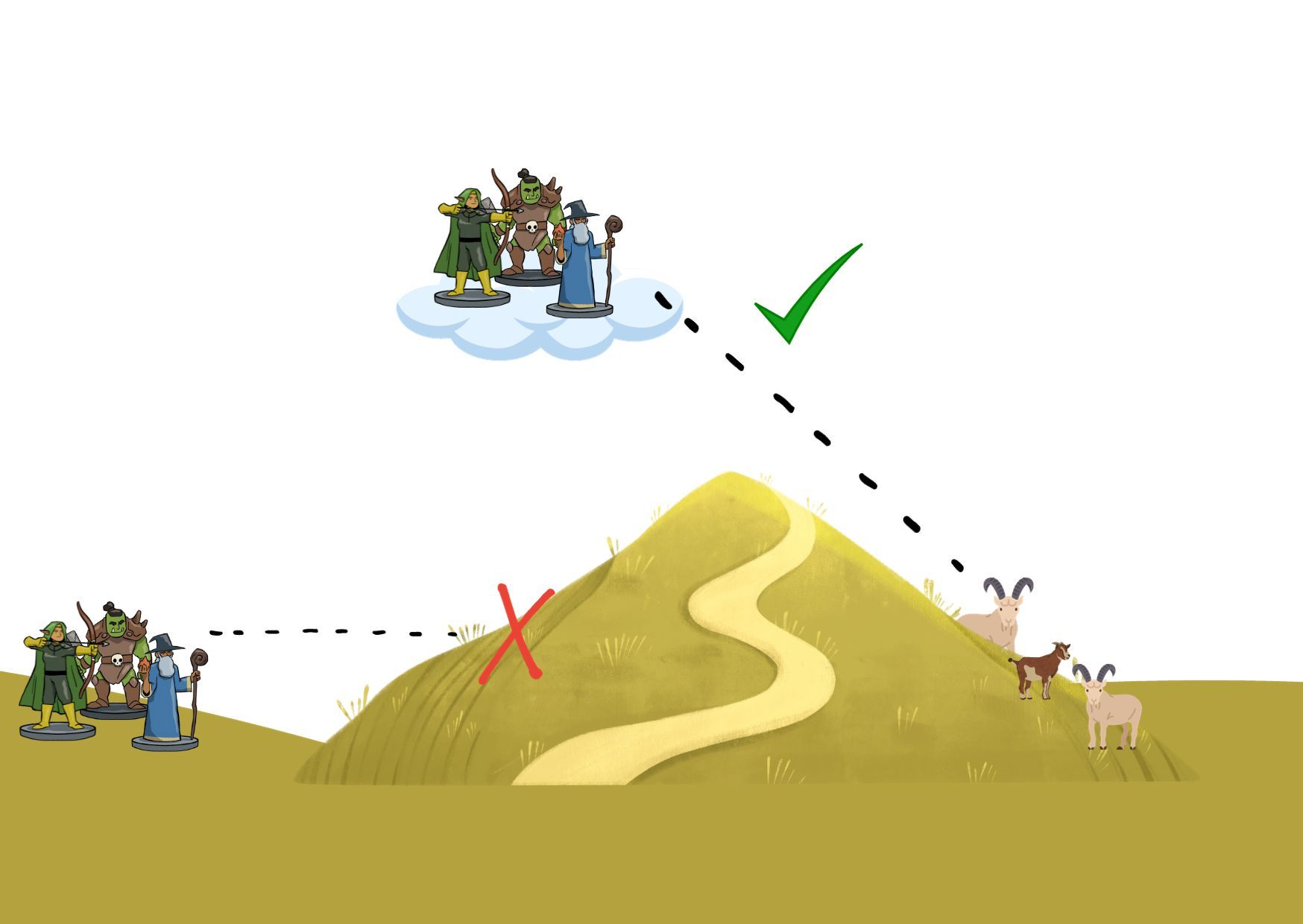
Sarcasm aside, the writing here is assuming that the GM and players (the table) won’t be able to imaginatively handle the nature of the world. This might seem a trivial thing that one could just ignore but actually there is an effort involved in that. Writing constrains. When as a writer, I tell the table that “these are the inputs and outcomes”, the table is either going to be inclined to follow these things or is going to have to make the mental effort to ignore them.
Theresa
In general, she still prefers to avoid combat, and teleports aways as soons she suspects any sort of danger, preferring to spy on the area and elminate assailants when the odds are firmly in her favor.
The comparison to our first example is not exact as these are very different styles of adventures. But the assumption of this one is so much that we, the table, will be able to figure out what to do in this situation. We will decide what “danger” and “the odds” look like to Theresa. There is no instruction of “if the players attack/cast a thrid level spell/when Theresa is sleeping”. We are being left to play imaginatively with the world.
Principle 2: Openness of outcomes
FKR adventures allow the play to determine the outcome of events. That is, they don’t try to limit or set deterministic outcomes. This may look like: specific outcomes not given; mechanics and other rules text not referred to.
Rod of 7 Parts
If the PCs attack the sentry and goatherds, the goats stampede them and then: Mounted characters who are not proficient riders automatically fall off their mounts and are trampled.
In this world as well as goats acting with suicidal violence at the merest hint of violence to their owners, horses are equipped with ejector buttons. When they sense the presence of danger and they can see on a rider’s character sheet that they don’t have proficiency they press the button and the rider flies off.
This is an example that builds on the lack of an assumption of creativity but adds to it that the writing is pre-determing the things that can happen in play. The writing is now telling me exactly how things will happen in our game. The horses cannot bolt, they won’t buck and kick, they won’t freeze in panic. Instead, 100% of the time the riders just fly off the saddle. We are essentially being asked to play the writer’s imaginination of the adventure.
Theresa
Theresa is going to liberate a village from an evil baron. She doesn’t know however that he has: set up ambushes and alarmed the locak knights. The characters must carefully navigate between wounding their ally’s pride and letting her walk in a deadly ambush.
Again this is an event happening at a different scale but again we see how the table is given the opportunity to play the game. We are given an event (a whole series of events) and left to see what the outcomes will be in-play. We aren’t playing the writer’s version of the story.
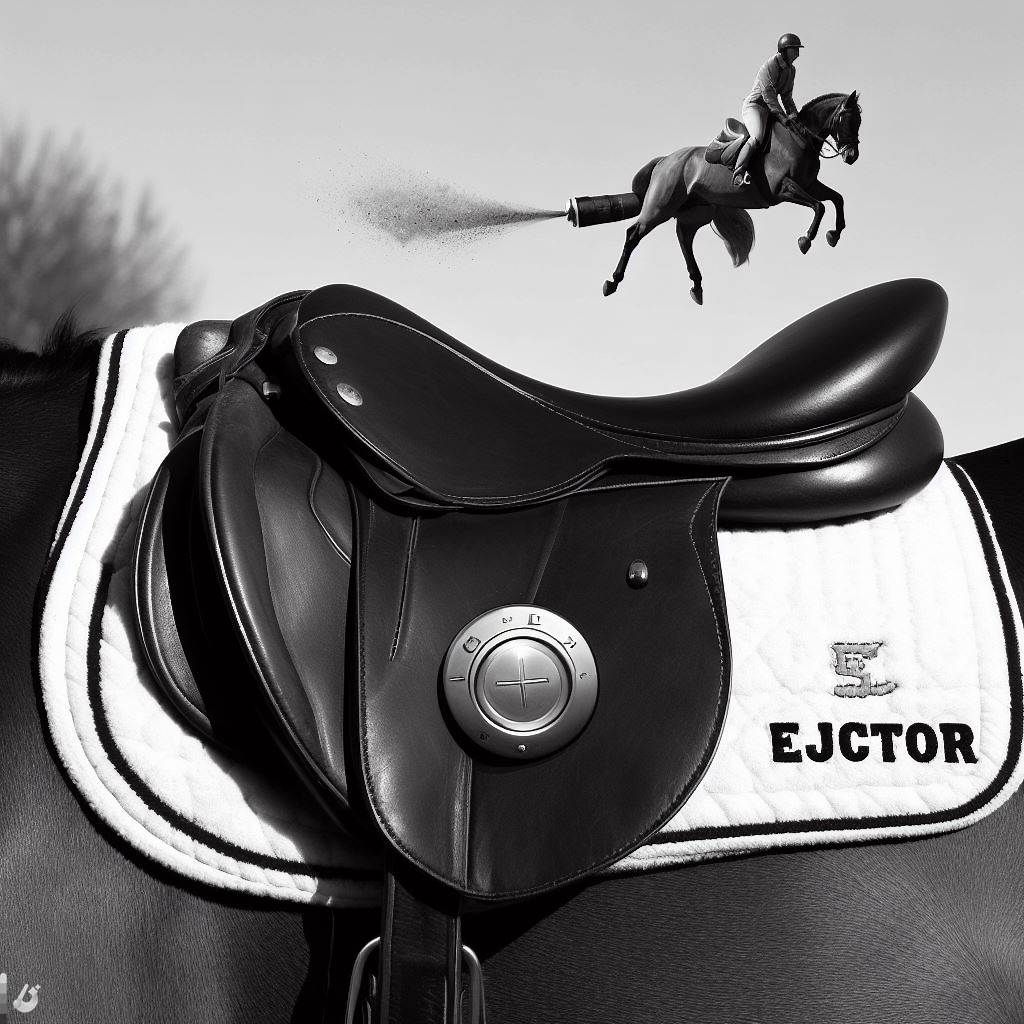 Image generated by Bing.
Image generated by Bing.
Principle 3: Simplicity of odds/adaptability of mechanics
AN FKR adventure should have odds that are easy to understand, or none at all. This relates to mechanics and their absence or simplicity. This may look like: no or limited maths and mechanics; simple, natural language description of outcomes and odds.
The Rod of 7 Parts
When the goats stampede The PCs have one round to stop the goats… characters must successfully save vs. breath or be knocked off their feet and trampled for 2d4 points of damage.
Here I think we have a more FKR element with the simplistic “save vs. breath”. Obviously in the original rules this is something that is tied to an individual character sheet which we can interpret now in any way we want. The damage is a bit harder to understand though if we don’t know the stats of a character in the system (which I don’t). We can probably guess that it isn’t a lot of damage but we would still have to figure this out in play.
Theresa
Theresa is a grandmotherly figure… She tries to project an aura of warm friendliness, even when she is in a situation that would require a decided unfriendly approach.
We have here a clear description of potential odds. If we are figuring out her reaction we can say that in maybe 9/10 situations she remains friendly and the players would have to push much further to see her lose her temper. That leaves us with the option to have more “natural” odds that depend on the situation as it emerges in play.
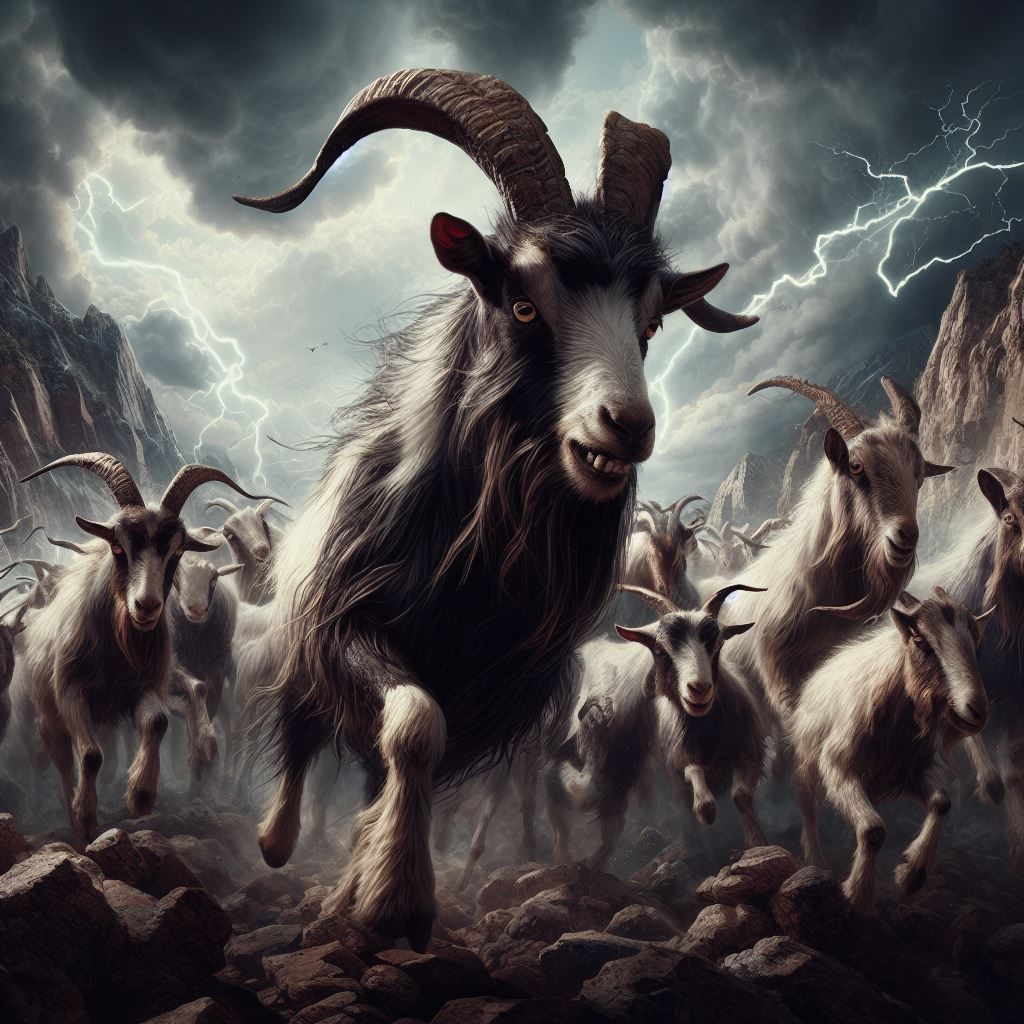 Image generated by Bing. How many d4 of damage is this?
Image generated by Bing. How many d4 of damage is this?
Principle 4: An emphasis on the evocative
An FKR adventure works to provide more to the imagination than it gives in words. This is very subjective but it may look like: giving details that have potential impact, without that impact being delineated.
Theresa
She is surrounded by a small retinue of undead servants.
Theresa is described in some detail as a character but this little detail alone gives us a lot to work with. It again allows us to imagine something more, the characters and personalities of the undead, the form they take. This is so much more evocative than “d6 zombies work as her servants”. We are free to develop the game in-play as we choose.
The Rod of 7 Parts
This is a slightly unfair example, as this adventure does have a lot of evocative writing in it. But it has some elements that are purely (in my opinion at least) anti-evocative. Let us describe what a genie is in this world of stampeding goats and ejector-horses:
Jann (Genie): AC5 (1 when invisible); MV 2, Fl 30(A); HD 6+2; hp 32; THATC0 15 (14 with Strength bonus); #AT 1 or 2; Dmg 2d8+4… or 1d6+4/id6+4… SA spell-like abilities; SZ M (6’ tall); ML champion (16); Int very (11)’ AL N (LE); XP 3,000; MM/126.
I’m sure you’ll agree that one can just picture this statbox floating through the desert air, casting its magic.
 Image generated by Bing. Good job Bing
Image generated by Bing. Good job Bing
Bonus principle: An objective or very subjective narrator
An FKR adventure either takes a strongly objective or subjective narrator. It tries not to define the thoughts, feelings, and perceptions of characters, either because it presents the world objectively or from a single, defined, narrative perspectice. This avoids language like “when the players enter the room they see… the players may feel…”.
This is my most personal and perhaps “literary” point. I think though it gets at something FKR that I have talked about here. FKR play is about play that emerges from the table itself. It isn’t about matching anyone’s pre-existing ideas and narratives. When, as writers, even in this subtle way, we try to determine what other people must experience when they play our adventures we are, in my opinion, taking a step beyond good writing, story-telling and “design.”.
I might return to this point in the future.
Itch: thewyrd.itch.io Twitter: @TheWyrdLands TikTok: @TheWyrdLands Email: wyrdrpgs@gmail.com
Adapting FEUD to Cairn
As part of releasing FEUD I wanted to try my hand at a couple of adaptions to other systems. This is partly because it was suggested by backers and partly because I have taken such a hard turn against “systems” in my design that I wanted to try and get back into thinking about RPGs this way.
I decided to start with Cairn as my first adaption, partly because of the designer’s incredible efforts in making it hackable (seriously, Cairn is the model for making a game system open) and also because the designer loves woods and forests and FEUD is set amidst the deepest of forests.
I live-streamed my design thoughts around FEUD and Cairn, and will be continuing to do so on The Wyrd Lands channel. The next step will adapting FEUD’s monsters and characters to Cairn.

When I started I immediately realised that in order to make FEUD be playable with Cairn that I needed to make a few changes to character creation to match the world of FEUD. This is because FEUD is informed by the very early medieval/late iron age rather that the medieval/renaissance world of Cairn. Therefore there is no currency, nor mass-produced metals etc.
Here is my current write-up of that, principally of the character creation. This will get a proper home, hopefully on the Cairn site, but I am putting it here while it is a work in progress.
Anything that is unchanged is unchanged.
Character Creation
If you wish your characters to be from the region itself, keep the same except for starting gear and below. Each character starts with access to as much food as they need and other tools that might be lent to them by their community.
If you wish your characters to be wandering adventurers, keep everything the same except for the below.
Name and Background
| Backgrounds (d12) | . | . | . |
|---|---|---|---|
| 1. Mot (Wrath) | 6. Karl (Human) | 11. Ful (Foul) | 16. Hvitr (White) |
| 2. Jofur (Boar) | 7. Vig (Battle) | 12. Vor (Vigilant) | 17. Mers (Fame) |
| 3. Bane (Bane) | 8. Wis (Wisdom) | 13. Nand (Daring) | 18. Leud (Spear) |
| 4. Uul (Temple) | 9. Leifr (Heir) | 14. Hialm (Helm) | 19. Aud (War) |
| 5. Geb (Gift) | 10. Arn (Eagle) | 15. Rafn (Raven) | 20. Valdr (Ruler) |
Roll once on the table above for a single name, twice to join the names together. Use either the original or “translated” word. E.g 1 and 5 is ‘Mot-geb’ or ‘Wrath Gift’.
| Backgrounds (d12) | . | . | . |
|---|---|---|---|
| 1. Herbalist | 4. Raider | 7. Farmer | 10. Priest |
| 2. Smith | 5. Shaman | 8. Justice | 11. Witch |
| 3. Forester | 6. Hunter | 9. Poet | 12. Trader |
Starting Gear (d20)
| Armour | . | . | . |
|---|---|---|---|
| 1-11 | 12-17 | 18-9 | 20 |
| Cloth | Thickened Cloth | Mail patches | Mail shirt |
| Shield and helmet | . | . | . |
|---|---|---|---|
| 1-10 | 11-16 | 17-9 | 20 |
| Old, cumbersome Shield and hood | Unwieldy shield and hood | Shield and thick cloth cap | Balanced shield and metal helm |
| Weapons | . | . |
|---|---|---|
| 1-11 | 12-17 | 18-20 |
| Roll once on table below | Roll twice | Roll three times |
| Weapons | . | . | . |
|---|---|---|---|
| 1. Ugly and awkward mallet | 6. Worn but dependable spear | 11. dull and awkward war axe | 16. Frail but elegant bow |
| 2. Frail wood axe | 7. Frail spear | 12. Worn bow | 17. Strong bow |
| 3. Old and bulky spear | 8. Refined spear | 13. Old but beautiful long knife | 18. Unbalanced long axe |
| 4. Tough but bulky mallet | 9. Bone pick | 14. Frail old sword | 19. Tough, ancestral spear |
| 5. Balanced wood axe | 10. Unwieldy and weak spear | 15. Tough war axe | 20. ugly old long knife |
There is a perchance generator for generating arms and armour in the world of FEUD.
| Expeditionary Gear | . | . | . |
|---|---|---|---|
| 1. Yard of cloth | 6. Herbal elixir | 11. Stone Maul | 16. Satchels |
| 2. String | 7. Poisonous herbs | 12. Stinking herbs | 17. Bladder |
| 3. Protective Amulet | 8. Long staff | 13. Trapping tools | 18. Cursing amulet |
| 4. Tinder | 9. Bone pick | 14. Wood spade | 19. Animal parts |
| 5. Herbal poultice | 10. Dowsing rod | 15. Household knife | 20. Wood whistle |
| Tools | . | . | . |
|---|---|---|---|
| 1. Bellows | 6. Clay pot | 11. Egg lubricant | 16. Net |
| 2. Carved bucket | 7. Bone/wood lever | 12. Stone hammer | 17. Small handaxe |
| 3. Animal teeth | 8. Awl | 13. Farming tool | 18. Plant resin |
| 4. Chalk/Stone | 9. Fishing rod | 14. Scraper | 19. Hoe |
| 5. Bone chisel | 10. Animal glue | 15. Wooden pins | 20. Wood tongs |
| Trinkets | . | . | . |
|---|---|---|---|
| 1. Clay bottle | 6. Horn | 11. Polished metal | 16. Dried entrails |
| 2. Playing pieces | 7. Metal bracelet | 12. Natural scents | 17. Knuckle bones |
| 3. Dice | 8. Rattle | 13. Witch stones | 18. Broch pin |
| 4. Face paints | 9. Wash cloths | 14. Salt | 19. Hair band |
| 5. Plant Bracelet | 10. Wood marbles | 15. Noise maker | 20. Comb |
Spellbooks
Most of these spellbooks should not be used. Those that can be specifically skinned as have an origin in the world of spirits or humans may be kept. That is, things that are “clearly magical” should be avoided. For example, telepathy or Summon Cube would not be appropriate, where Pacify and Hatred may be interpreted as the result of a poet’s wit or a hunter’s personality.
Prices and Equipment list
Gold and currency is not something that exists in the world of FEUD. Where things have a relative value the values given should be seen as a “category of value” that may have an effect in trade and bartering. For example, an object work 5 may be traded for another of similar value.
However, it is unlikely that these opportunities for trade will arise too often. Therefore you will have to rely on your neighbours who may loan you items, or you may have access to shared/communal equipment.
Announcing The Wyrd Lands
This site is the new home of writing about The Wyrd Lands.
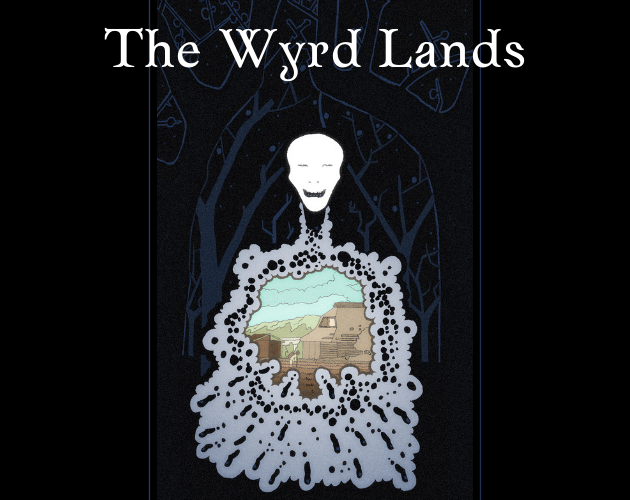
The Wyrd Lands is a setting. Whenever my imagination wanders in search of adventures, monsters and humanity, it winds away among the forests and bogs of The Wyrd Lands.
The Wyrd Lands is a game or rather it is the tool for people to produce their own corners of this world and play within it however they see fit. It is random generators and descriptive tables of the cultures and land. It is individual adventures, stories and characters to populate your own stories and play.
This site is going to capture my on-going work with developing tales, legends and art of this world and ways to play within it. I hope you’ll keep track of what I am up to in order to get more from this strange world.
What is coming next?
FEUD has just funded. This stand-alone system-neutral RPG adventure was created using the tools of The Wyrd Lands RPG. This system is in some respects “completed” but is not yet released in full.
I am going to be working on releasing more of this system here and on my itch.io page. I will be starting by introducing the GM role for the game, that of The Wyrd itself.
I have also begun working on the next adventure. It’s working title is ‘She, The Peacock; It, the Empress’. This will tell the tale of one of the most important figures in all the Wyrd-Lands, the slave-girl become Empress, wand-bearer and invader. The Peacock’s story is the story of the beginning of the end of The Wyrd Lands.
I am also beginning to seriously re-write a novel set in this land. I wrote this first about 8 years ago but before I had the will to try and publish and share my writing. I now, finally, do and I am beginning to re-approach this tale. A tale of a wizard who returns with a new apprentice to The Wyrd Lands as it is taking its painful, breaths.
Please follow me on my socials to keep adventuring in this strange and dangerous land.
Twitter: @TheWyrdLands Itch: thewyrd.itch.io TikTok: @TheWyrdLands Email: wyrdrpgs@gmail.com